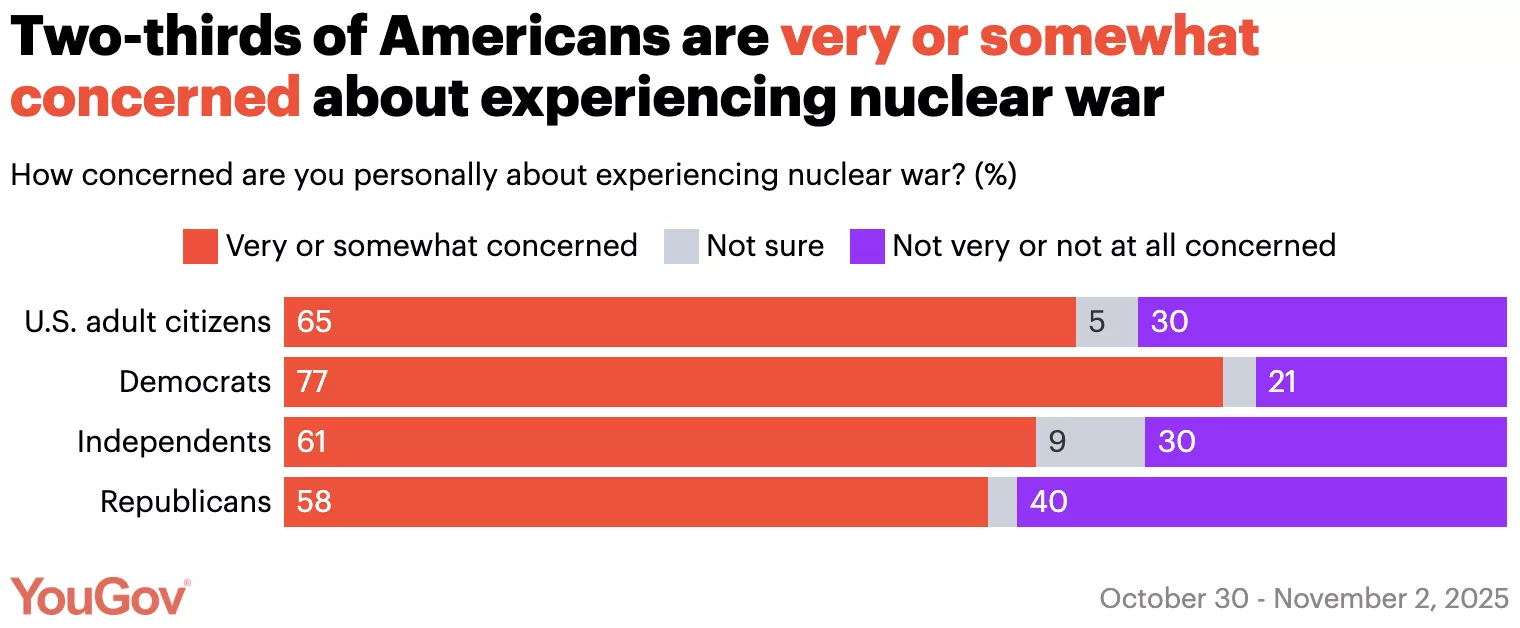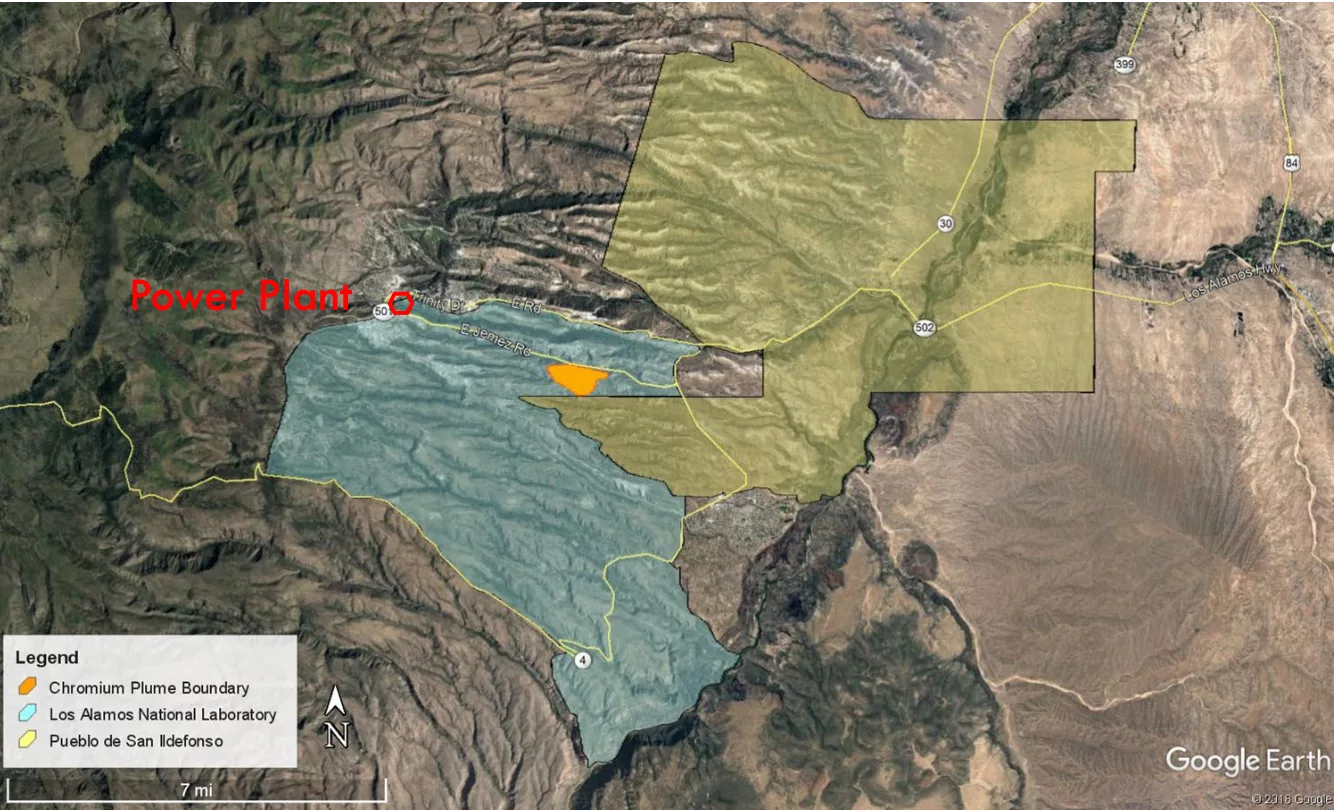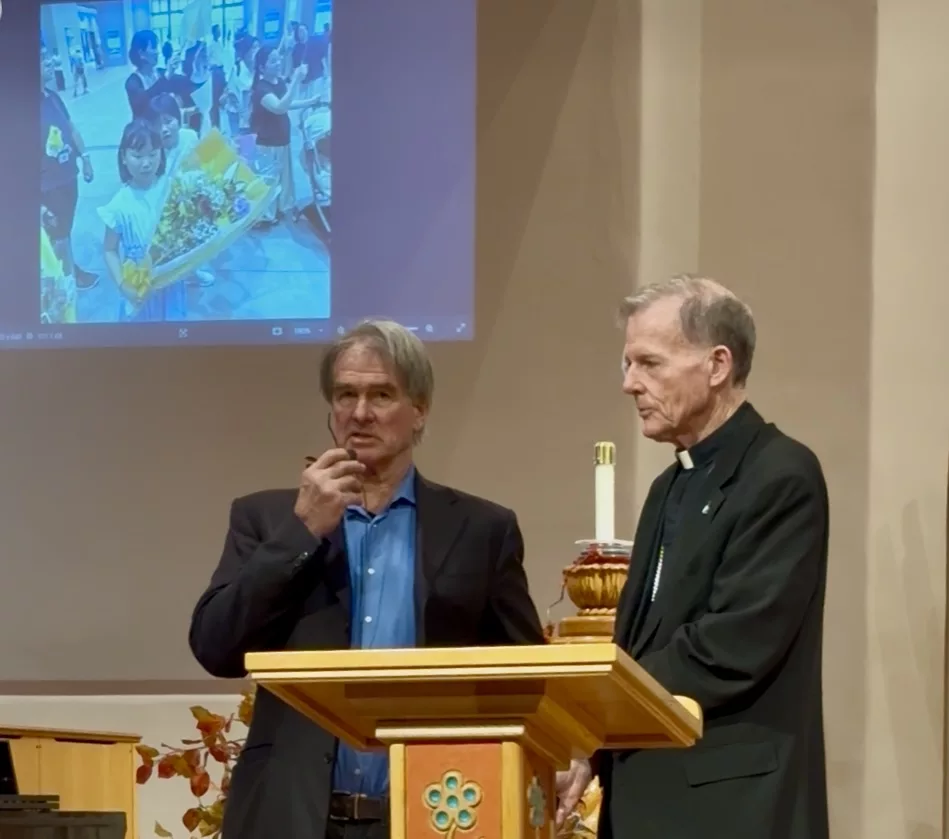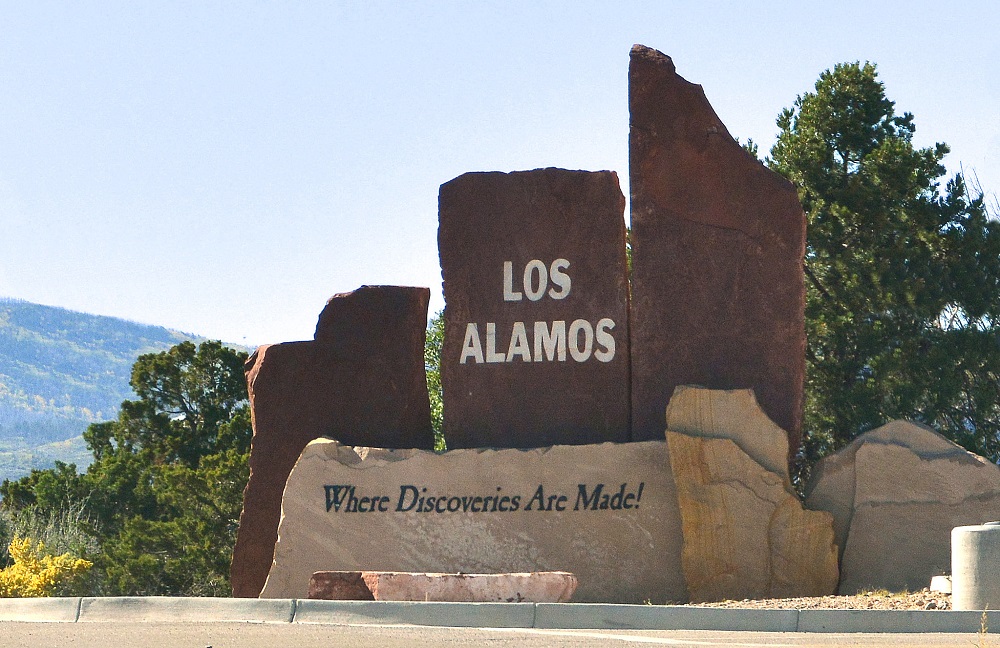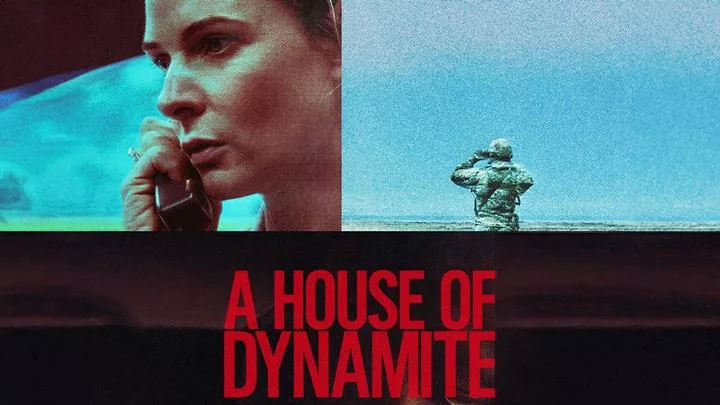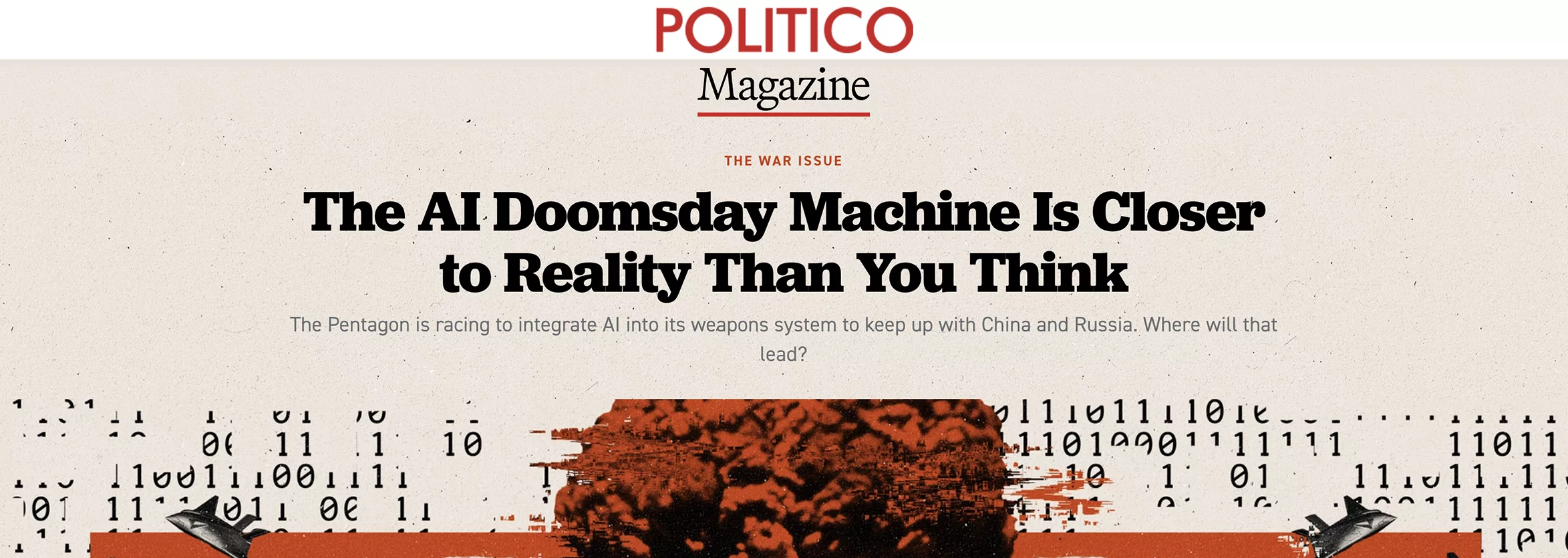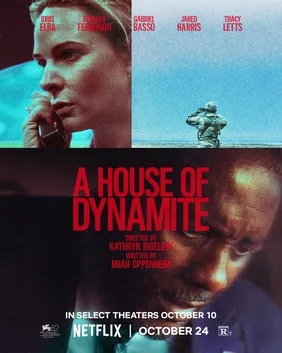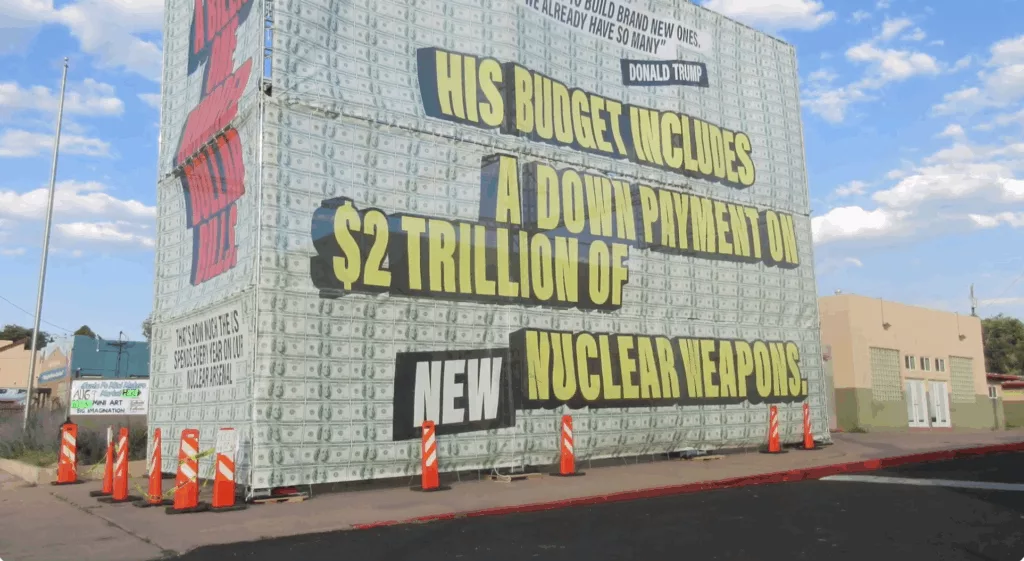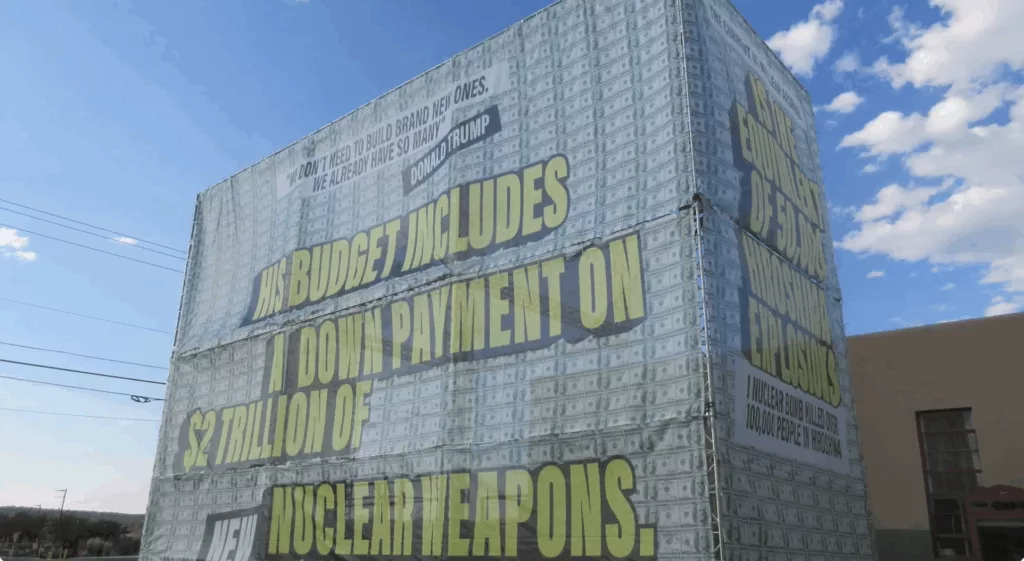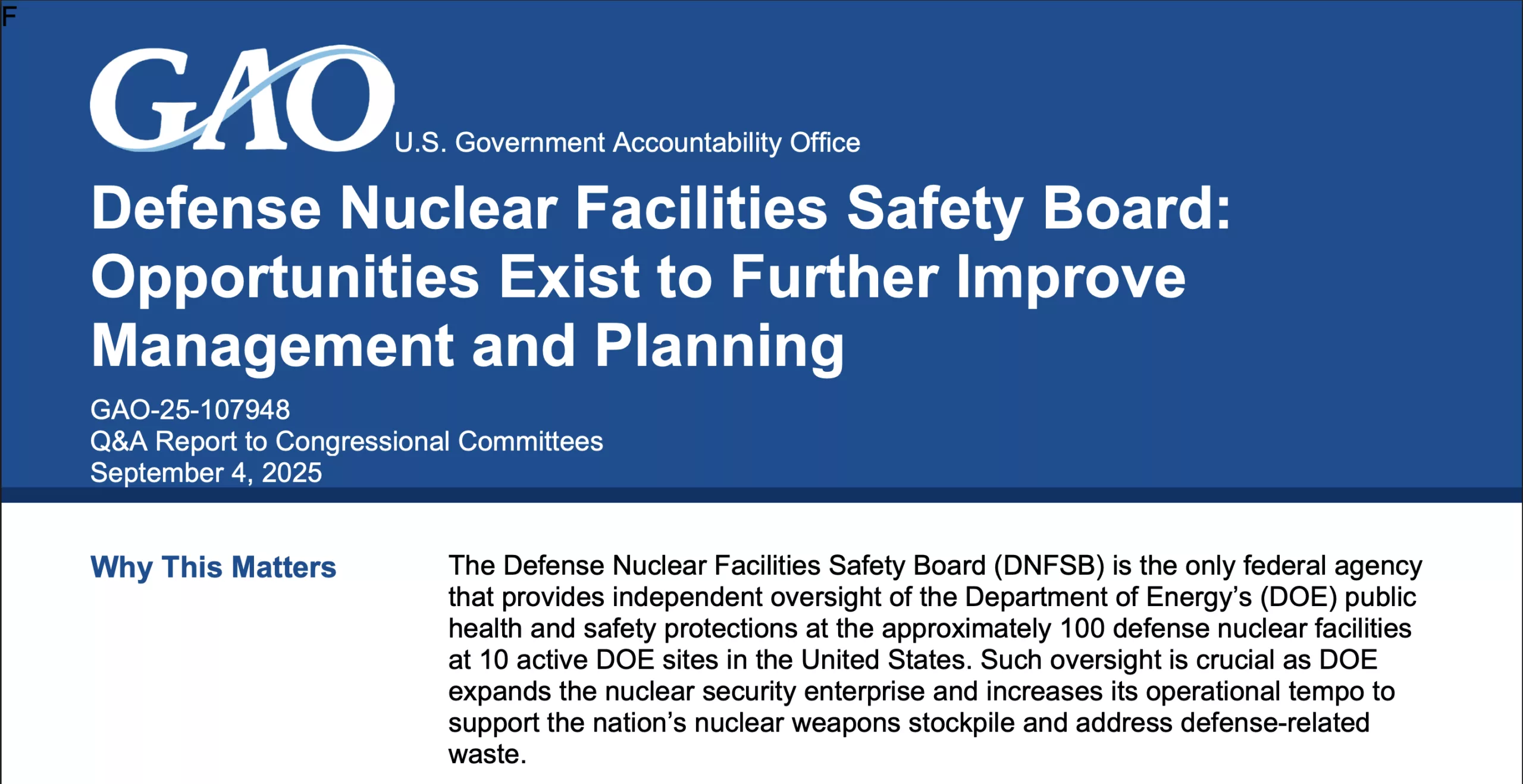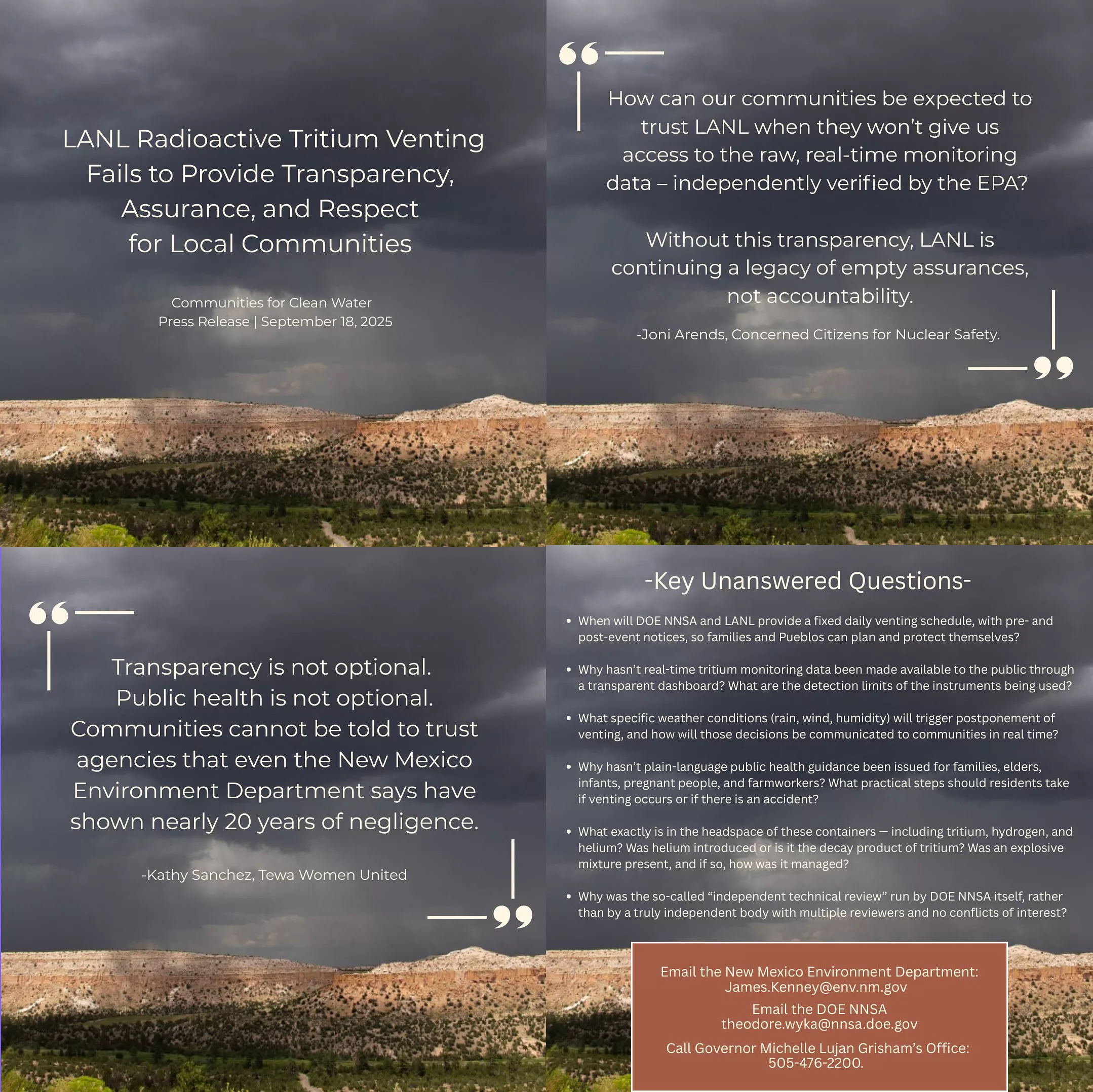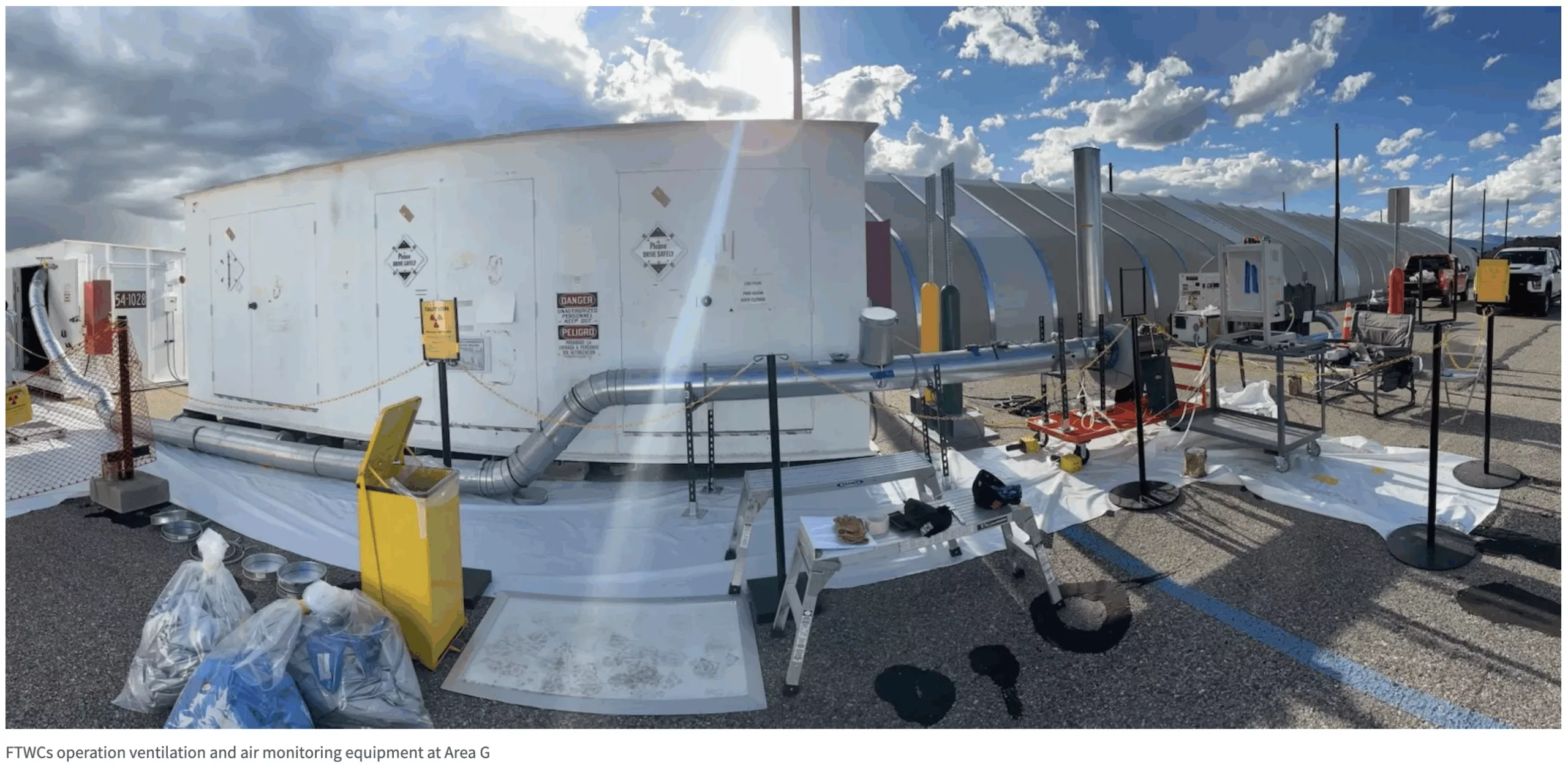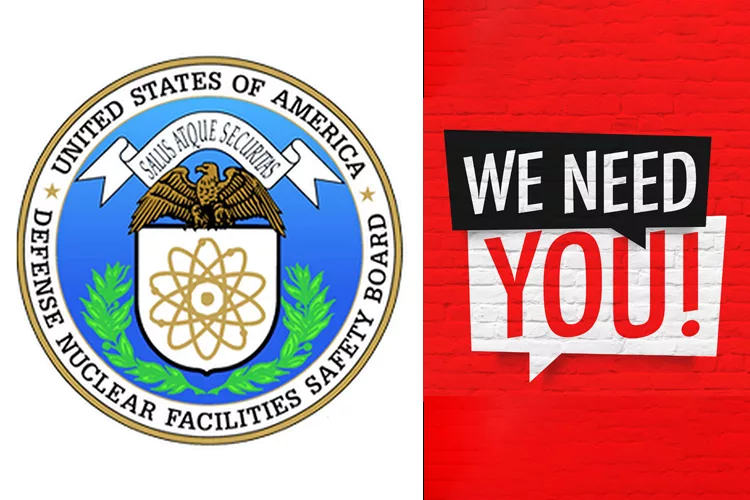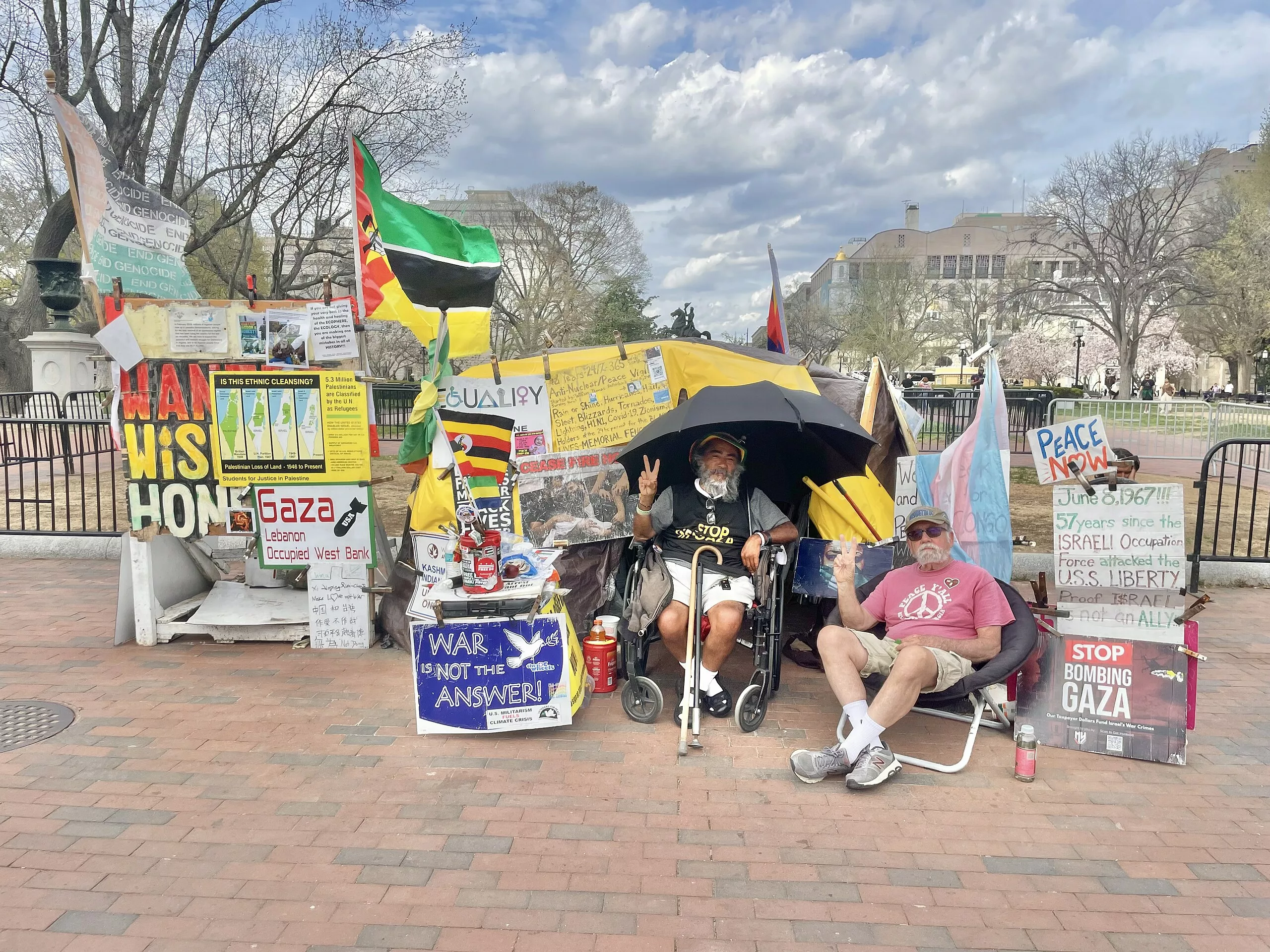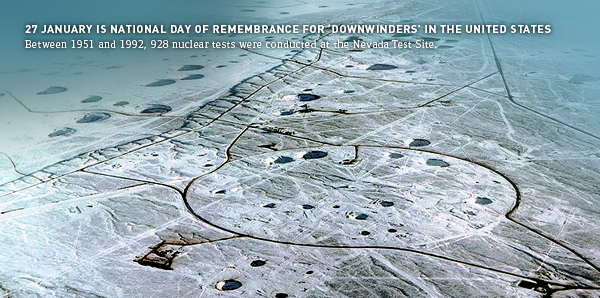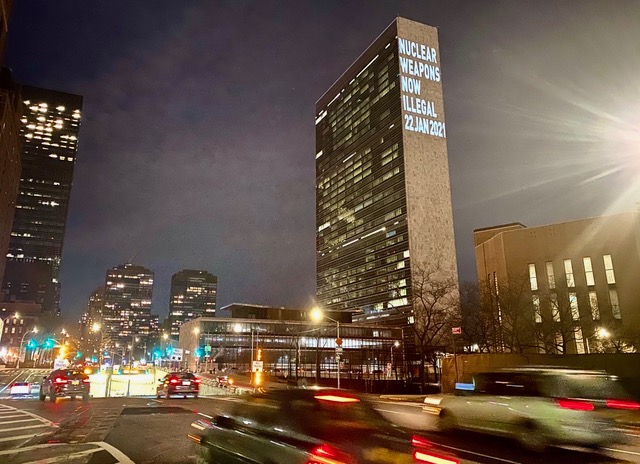What might Project 2025 mean for N.M.? Non-nuclear cuts at national labs (Updated Dec 1, 2025)
“[The Heritage Foundation’s Project 2025] contemplates pulling funding from any work unrelated to nuclear weapons at Los Alamos National Laboratory, Sandia National Laboratories and sister facility Lawrence Livermore National Laboratory in California…in New Mexico, some say cutting the labs’ other scientific work would have a devastating economic effect on the state and could ultimately weaken the institutions as a whole.”
“It doesn’t take a nuclear physicist to realize that there could be massive layoffs if this proposal or these ideas were to reach fruition,” said Chandler, who worked in the employment arena for much of her time at the facility. “Now, that might expand the nuclear weapons program to some degree, but it’s not going to absorb the entire workforce.”
“Under the Biden administration, LANL has seen a massive growth in employment as the laboratory ramps up for its production of plutonium pits, the cores of nuclear bombs.”
By Gabrielle Porter and Alaina Mencinger gporter@sfnewmexican.com amencinger@sfnewmexican.com | Updated santafenewmexican.com
Project 2025 — the now-infamous blueprint for a conservative presidency that’s still publicly being held at arm’s length by Republican presidential candidate Donald Trump — proposes all sorts of sweeping policy recommendations, from promoting capital punishment to embracing mass deportations.
But tucked in the 922 pages of its report, “Mandate for Leadership 2025: The Conservative Promise,” is one recommendation that centers squarely on New Mexico.
Trump talk on nuke testing turns focus to New Mexico’s role in decades of blasts
Jay Coghlan, executive director of the nuclear watchdog group Nuclear Watch New Mexico, said Wright’s comments “somewhat” quelled his initial concerns about a renewed explosive nuclear testing program.
But he said claims Russia and China may be conducting small-scale tests known as hydronuclear tests — banned by the Comprehensive Nuclear Test Ban Treaty, of which the United States, Russia and China are all signatories — continue to give him pause. He fears rumors about the low-yield tests in other nations could be used to justify a domestic return to testing.
“That, in effect, would give permission to the U.S. [to resume testing],” Coghlan said. “But that would be in violation of the norm of the CTBT.”
Three decades removed from the United States’ last nuclear test, a testing regimen would likely be expensive and time-consuming to start up, Coghlan argued, and could prompt other nuclear powers to follow suit.
It seems likely Russia, at least, would: Following Trump’s post, Russian President Vladimir Putin announced if the United States resumed explosive nuclear testing, the Eastern European nation would follow.
“Then everybody else is going to do it, or virtually everybody else will do it, every other nuclear weapons power,” Coghlan said. “I could just see India and Pakistan champing at the bit to test. And then, of course, there’s North Korea and China.”
By Alaina Mencinger amencinger@sfnewmexican.com | November 30, 2025 santafenewmexican.com
It might not have as reverent a name as the Trinity Test or a litany of films made about it. But Project Gnome, a 1961 explosive nuclear test conducted near Carlsbad, is a relic of a bygone era in New Mexico and beyond.
In the 47 years between the Trinity Test and the end of the United States’ explosive nuclear testing in 1992, the nation would perform more than 1,000 such tests — more than any other nuclear nation — with most conducted in Nevada.
New Mexico might not have been the center of the nation’s testing efforts post-Trinity, which marked its 80th anniversary this year, but the state still played a role: Researchers from Sandia National Laboratories and Los Alamos National Laboratory helped design and conduct testing elsewhere, including at the Nevada Test Site and in the Marshall Islands.
Most Democrats and one-third of Republicans think it’s likely the U.S. will get into a nuclear war in the next decade
A new YouGov poll on nuclear weapons finds that nearly half of Americans believe it’s likely the U.S. will get into a nuclear war in the coming decade, and most are worried about personally experiencing a nuclear war. A majority believe nuclear weapons are making the world less safe, but opinions are mixed on whether the U.S. should dismantle all of its nuclear weapons.
By: Jamie Ballard| November 26, 2025 today.yougov.com
46% of Americans think it’s likely the U.S. will get into a nuclear war within the next 10 years; 37% think this is not very or not at all likely. 57% of Democrats and 37% of Republicans think this is likely.
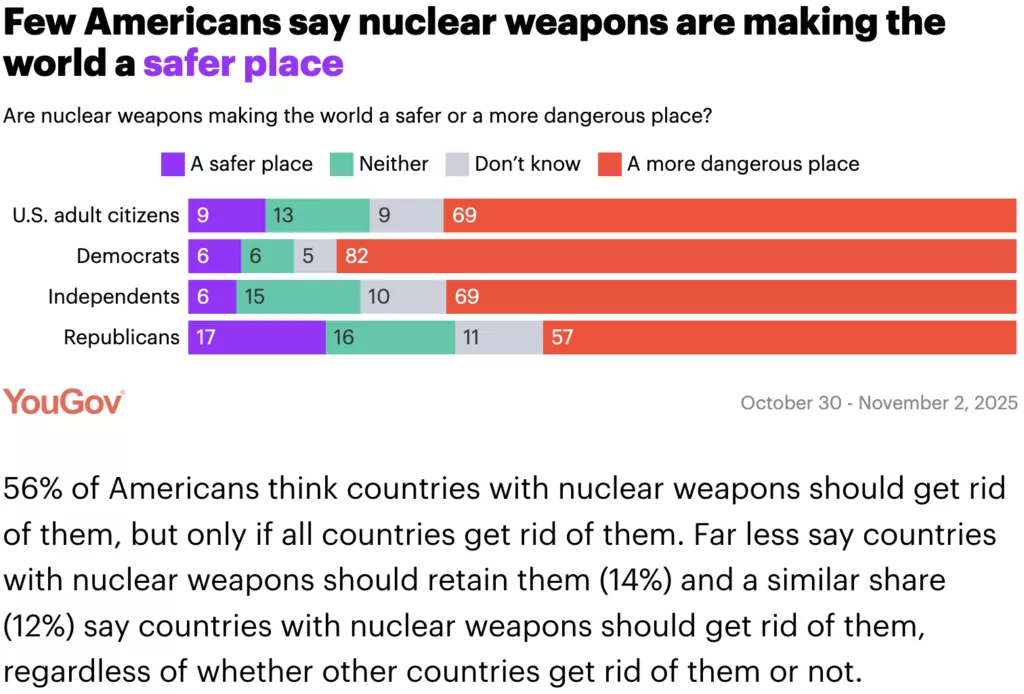
Department of Energy Seeks to Eliminate Radiation Protections Requiring Controls “As Low As Reasonably Achievable”
An internal Department of Energy (DOE) memorandum eliminates worker and public radiation protection rules known “As Low As Reasonably Achievable” (ALARA). This fundamental departure from decades of accepted health physics practices is being promoted by senior DOE political appointees with little background in health or radiation control. It is marked as “URGENCY: High” under the auspices of the DOE Deputy Secretary, the Under Secretary for Science, and the Administrator of the National Nuclear Security Administration. The memorandum awaits the final signature of DOE Secretary Chris Wright.
The memo’s stated goal is to:
“…remove the ALARA principle from all DOE directives and regulations, including DOE Order 458.1, Radiation Protection of the Public and the Environment, NE [Office of Nuclear Energy] Order 458.1, Radiation Protection of the Public, and, upon completion of the rulemaking process, 10 CFR [Code of Federal Regulations] 835, Occupational Radiation Protection.” [1]
It follows the playbook of the Heritage Foundation’s Project 2025, which called for:
“Set[ting] clear radiation exposure and protection standards by eliminating ALARA (“as low as reasonably achievable”) as a regulatory principle and setting clear standards according to radiological risk and dose rather than arbitrary objectives.” [2]
Lab Chromium Contamination Confirmed on San Ildefonso Pueblo Land
Comprehensive Cleanup Needed Instead of More Nuclear Weapons
The New Mexico Environment Department has announced:
“A toxic chromium plume from Los Alamos National Laboratory has spread beyond Lab boundaries onto Pueblo de San Ildefonso land for the first time, with contamination exceeding state groundwater standards… These new results are conclusive evidence that the U.S. Department of Energy’s efforts to contain the chromium plume have been inadequate.”
In reality, chromium groundwater contamination probably migrated beyond the LANL/San Ildefonso Pueblo boundary long ago, with past Lab maps of the plume “magically’ stopping at the border. In the past, tribal leadership has commented that it was fortunate that the contamination stopped there, but that any future indications of groundwater contamination on Pueblo land could have serious consequences. The San Ildefonso Pueblo is a sovereign Native American tribal government.
As late as the late 1990s the Lab was falsely claiming that groundwater contamination was impossible because underlying volcanic tuff is “impermeable.” [1] This ignored the obvious fact that the Parajito Plateau is heavily seismically fractured, providing ready pathways for contaminant migration to deep groundwater. By 2005 even LANL acknowledged that continuing increasing contamination of the regional aquifer is inevitable.[2] Some 300,000 northern New Mexicans rely upon the aquifer for safe drinking water. The potential serious human health effects (including cancer) caused by chromium contamination was the subject of the popular movie Erin Brockovich.
LANL chromium plume spreads onto San Ildefonso Pueblo land, NMED says
Nuclear Watch New Mexico executive direcor Jay Coghlan sees PF-4 as being a bigger scale — and having bigger risks — than the other aging buildings.
“PF-4 is not unique in being old,” Coghlan said. “However, PF-4 is totally unique in currently being the only facility that can process large amounts of plutonium … particularly including plutonium pit production. I think, in part, that’s why the Safety Board focuses more on PF-4 than, to my knowledge, than any other single individual facility.”
By:Patrick Lohmann | November 13, 2025 sourcenm.com
An underground plume of toxic chromium has spread from Los Alamos National Laboratory to Pueblo de San Ildefonso land, state Environment Department officials announced Thursday.
The discovery marks the first time the plume has been detected within the pueblo boundaries, officials said in a news release, though they added the plume’s spread does not pose imminent threats to drinking water in the pueblo or in Los Alamos County. That’s because the plume is not near any known private or public wells, officials said.
Long-term ingestion of hexavalant chromium can cause serious health problems or increase risk of certain cancers.
US Stands Alone Defying UN Vote on Nuclear Test Ban Treaty
Could the LDS Church end an ongoing nuclear weapons project? These veteran activists think so.
By Thalif Deen, Inter Press Sevice | November 12, 2025 ipsnews.net
UNITED NATIONS, Nov 12 2025 (IPS) – The US took another step backward –to break ranks with the United Nations– when it voted against a draft resolution calling for the entry into force of the Comprehensive Nuclear-Test-Ban Treaty (CTBT).
The negative vote followed an announcement by President Trump last month that the US plans to resume nuclear testing after a 33-year hiatus. The US stood alone on the UN vote, which was supported by almost all member States in the General Assembly’s First Committee.
The resolution was adopted by an overwhelming majority: with 168 votes in favor, with one against (United States) and 3 abstentions (India, Mauritius, Syria).
During Trump’s first term, the US abstained on the vote. And in other years they had been voting in favour.
Jackie Cabasso, Executive Director, Western States Legal Foundation, which monitors and analyzes U.S. nuclear weapons programs and policies, told IPS the chaos and uncertainty arose from Trump’s factually-challenged social media post that “because of other countries testing programs, I have instructed the Department of War to start testing our Nuclear Weapons on an equal basis.”
The U.S. government’s first ever “No” vote, on the annual UN resolution in support of the Comprehensive Test Ban Treaty (CTBT), raises further troubling questions about U.S. intentions.
Harking to the MX, Utahns call on LDS Church President Oaks to speak out against nuclear missile being developed in Utah
Could the LDS Church end an ongoing nuclear weapons project? These veteran activists think so.
THE SALT LAKE TRIBUNE | November 9, 2025 sltrib.com
Decades ago, peace activists helped keep a major nuclear weapons system out of Utah with help from key figures, chiefly Spencer W. Kimball, then the president of The Church of Jesus Christ of Latter-day Saints.
Now some of those same individuals are calling on the church’s newly ascended president, Dallin H. Oaks, to follow in his predecessor’s footsteps and speak out against the federal government’s development of a new generation of nuclear missile, known as Sentinel, partly in the Beehive State.
“The arms race continues,” the group of 12 Utahns and one former resident write in a letter mailed to church headquarters in early October, “and a new moral challenge faces” the leaders of the Utah-based faith.
Nuclear Weapons Issues & The Accelerating Arms Race: November 2025
Nuclear weapons:
The government shutdown has impact:
National Nuclear Security Agency confirms 152 furloughed at offices in Albuquerque, Los Alamos
Only 14 employees remain at the two sites By: Danielle Prokop-October 22, 2025
The NNSA confirmed 152 New Mexico employees charged with overseeing national laboratories’ nuclear weapons work were furloughed on Oct. 20, 2025. (Courtesy of NNSA)
The federal government this week sent home more than 150 federal New Mexico employees charged with overseeing national laboratories’ nuclear weapons work, with only 14 employees across two sites remaining at work, the National Nuclear Security Agency confirmed to Source NM.
The furloughs include 71 employees at NNSA’s Los Alamos field office and 81 at the Sandia National Laboratories location, NNSA Deputy Director of Communications Laynee Buckels told Source NM in an email. Seven employees remain at each site, working without pay, she said.
The field offices are responsible for “ensuring compliance with federal contracts to manage and operate the national security assets,” according to the NNSA website
To date there doesn’t appear to be furloughs at LANL, whose employees technically work for a contractor rather than the federal government. Congress is not furloughed, but Speaker Mike Johnson has kept the House out of session. As a result, legislation has come to a screeching halt.
Los Alamos’ plutonium facility safety systems need improvement, oversight board says
Nuclear Watch New Mexico executive direcor Jay Coghlan sees PF-4 as being a bigger scale — and having bigger risks — than the other aging buildings.
“PF-4 is not unique in being old,” Coghlan said. “However, PF-4 is totally unique in currently being the only facility that can process large amounts of plutonium … particularly including plutonium pit production. I think, in part, that’s why the Safety Board focuses more on PF-4 than, to my knowledge, than any other single individual facility.”
By Alaina Mencinger amencinger@sfnewmexican.com | November 7, 2025 santafenewmexican.com
An independent oversight agency wants to see improved safety systems at the facility at the heart of Los Alamos National Laboratory’s plutonium pit mission: PF-4.
The Defense Nuclear Facilities Safety Board reported what it believes to be gaps in a safety analysis drafted for PF-4 and delays in upgrades to safety systems in a letter last month to Energy Secretary Chris Wright.
“Maintaining momentum for these safety infrastructure projects is more important in light of the issues with the safety analysis,” the board wrote in the letter dated Oct. 10. It was signed by former acting chairman Thomas Summers.
LANL Prioritizes Plutonium “Pit” Bomb Core Production Over Safety
The independent Defense Nuclear Facilities Safety Board recently released its Review of the Los Alamos Plutonium Facility Documented Safety Analysis. It concluded that:
“While LANL facility personnel continue to make important upgrades to the Plutonium Facility’s safety systems, many of those projects have encountered delays due to inconsistent funding and other reasons. DOE and LANL should consider prioritizing safety-related infrastructure projects to ensure that the Plutonium Facility safety strategy adequately protects the public, as the facility takes on new and expansive national security missions.” (Page 24)
In early October 2024, the Department of Energy’s semi-autonomous National Nuclear Security Administration (NNSA) announced with great fanfare that the Los Alamos Lab had produced its first “diamond stamped” plutonium pit for the nuclear weapons stockpile. Tens of billions of taxpayers’ dollars have been sunk into LANL’s long delayed and over budget pit production program. Given no further announcements, it is not currently known whether or not the Lab is meeting its congressionally required production goals. Endemic nuclear safety problems have long been an intractable issue, at one point even forcing a three-year halt to plutonium operations at LANL’s Plutonium Facility-4 (“PF-4”).
In its recent Review, the Safety Board reported:
“The [2009] Plutonium Facility safety basis described very large potential [radioactive] dose consequences to the public following seismic events…. DOE committed to upgrade and seismically qualify the ventilation system, with a particular focus on a specific ventilation subsystem…”
“As the only facility in the DOE complex that can process large quantities of plutonium in many forms, [PF-4] represents a unique capability for the nation’s nuclear deterrent. The Board has long advocated for the use of safety-related active confinement systems in nuclear facilities for the purposes of confining radioactive materials…Passive confinement systems are not necessarily capable of containing hazardous materials with confidence because they allow a quantity of unfiltered air contaminated with radioactive material to be released from an operating nuclear facility following certain accident scenarios. Safety related active confinement ventilation systems will continue to function during an accident, thereby ensuring that radioactive material is captured by filters before it can be released into the environment… (Page 2, bolded emphases added)
AP: Trump appears to suggest the US will resume testing nuclear weapons for first time in 30 years
“For Trump, who has cast Russia as a “paper tiger” for failing to swiftly subdue Ukraine, the message is that Russia remains a global military competitor, especially on nuclear weapons, and that Moscow’s overtures on nuclear arms control should be acted on.”
By MICHELLE L. PRICE and CHRIS MEGERIAN | October 30, 2025 apnews.com
BUSAN, South Korea (AP) — President Donald Trump appeared to suggest the U.S. will resume testing nuclear weapons for the first time in three decades, saying it would be on an “equal basis” with Russia and China.
The Kremlin pointed out that a global ban on nuclear tests has remained in place, but warned that if any country resumes nuclear testing Russia would follow suit.
There was no indication the U.S. would start detonating warheads, but Trump offered few details about what seemed to be a significant shift in U.S. policy.
He made the announcement on social media minutes before he met with Chinese leader Xi Jinping on Thursday in South Korea. He offered little clarity when he spoke to reporters later aboard Air Force One as he flew back to Washington.
The U.S. military already regularly tests its missiles that are capable of delivering a nuclear warhead, but it has not detonated the weapons since 1992. The Comprehensive Nuclear Test Ban Treaty, which the U.S. signed but did not ratify, has been observed since its adoption by all countries possessing nuclear weapons, North Korea being the only exception.
REUTERS: Trump tells Pentagon to immediately resume testing US nuclear weapons
“Russia – which tested a new nuclear-powered cruise missile on October 21, held nuclear readiness drills on October 22 and tested a new nuclear-powered autonomous torpedo on October 28 – said it hoped Trump had been properly informed that Moscow had not tested a nuclear weapon itself.”
By Trevor Hunnicutt, Ismail Shakil and Kanishka Singh | October 30, 2025 reuters.com
VIEW THE RECORDING: Santa Fe Ecumenical Conversations Towards Nuclear Disarmament at Santa Maria de la Paz Catholic Community – Monday, October 27
Archbishop John C. Wester and NukeWatch New Mexico presented a special evening at Santa Maria de la Paz Catholic Community on Monday, October 27, from 6:00 to 8:00 p.m. MT. Following a presentation from NukeWatch executive director Jay Coghlan on U.S. nuclear weapons “modernization,” the Archbishop shared reflections from his pastoral letter, Living in the Light of Christ’s Peace, and speak about the importance of dialogue and hope in working toward nuclear disarmament.
View the recording at https://www.youtube.com/watch?v=9LFmQzMoJds&t=1s
Trump Orders Nuclear Weapons Testing for New Nuclear Arms Race
New Plutonium “Pit” Bomb Cores at Los Alamos Lab Could Make It Real
Just minutes before meeting with Chinese President Xi Jinping, Trump posted on his Truth Social media platform that “Because of other countries testing programs, I have instructed the Department of War to start testing our Nuclear Weapons on an equal basis. That process will begin immediately.” House Speaker Mike Johnson soon followed on CNN saying, “I think it is an obvious and logical thing to ensure that our weapons systems work.”
No other countries are currently testing nuclear weapons (the last was by North Korea in 2017). Further, any nuclear weapons tests by the U.S. would be performed by the Department of Energy (whose last test was in 1992), not the Department of War (until recently the Department of Defense). Trump was likely referring to Vladimir Putin’s recent claims of a new nuclear powered cruise missile and a tsunami-causing nuclear-armed torpedo that could threaten America’s coastal cities. In addition, China is dramatically expanding its own fleet of intercontinental ballistic missiles.
But central to all this is the U.S.’ own $2 trillion “modernization” program that will rebuild every nuclear warhead in the planned stockpile with new military capabilities and produce new-design nuclear weapons as well. This so-called modernization program will also build new nuclear weapons production facilities expected to be operational until ~2080, and buy new missiles, subs, and bombers from the usual rich defense contractors, all to keep nuclear weapons forever.
‘Nuclear weapons are blasphemous’: Archbishop Wester continues disarmament push with talk
This event was organized by the “Santa Fe Ecumenical Conversations Towards Nuclear Disarmament” group at the Santa Maria de la Paz parish near the Santa Fe Community College. They kindly invited NukeWatch to speak before Archbishop Wester for what turned out to be a wonderful event. The full recording can be viewed at https://www.youtube.com/@SMDLP/streams
By Cormac Dodd cdodd@sfnewmexican.com | October 28, 2025 santafenewmexican.com
Despite saying he has received a somewhat muted response from the local faithful, Santa Fe’s Catholic archbishop is still pushing nuclear disarmament as vital to humanity’s spiritual well-being and continued existence.
“I think nuclear weapons are blasphemous, because I think nuclear weapons are humanity’s attempt to build a Tower of Babel, an attempt to eat from the apple of the tree of the Garden of Eden, to become like God, to become gods,” Archbishop John C. Wester said in a roughly 30-minute address at Santa Maria de la Paz Catholic Church south of Santa Fe.
“In humility, we must avoid inventing anything that, in a matter of hours, can destroy what God has created,” the leader of the Archdiocese of Santa Fe continued. “The story of Adam and Eve is archetypal, I think: When human beings try to become as God, they lose the Garden of Eden and they must endure the cruel reality of paradise lost.”
The archbishop’s comments followed a journey he undertook to Japan on the 80th anniversary of the U.S. military’s decision to drop atomic bombs on Hiroshima and Nagasaki toward the end of World War II. He spoke in front of an audience of about 50 people — who gave Wester a standing ovation — at Monday’s event
In a Looming Nuclear Arms Race, Aging Los Alamos Faces a Major Test
The lab where Oppenheimer developed the atomic bomb is the linchpin in the United States’ effort to modernize its nuclear weapons. Yet the site has contended with contamination incidents, work disruptions and old infrastructure.
By Alicia Inez Guzmán | October 28, 2025 The New York Times nytimes.com
In a sprawling building atop a mesa in New Mexico, workers labor around the clock to fulfill a vital mission: producing America’s nuclear bomb cores.
The effort is uniquely challenging. Technicians at Los Alamos National Laboratory must handle hazardous plutonium to create the grapefruit-size cores, known as pits. They do so in a nearly 50-year-old building under renovation to address aging infrastructure and equipment breakdowns that have at times disrupted operations or spread radioactive contamination, The New York Times found.
Now, the laboratory is under increasing pressure to meet the federal government’s ambitions to upgrade the nation’s nuclear arsenal. The $1.7 trillion project includes everything from revitalizing missile silos burrowed deep in five states, to producing new warheads that contain the pits, to arming new land-based missiles, bomber jets and submarines.
But the overall modernization effort is years behind schedule, with costs ballooning by the billions, according to the Congressional Budget Office. In 2018, Congress charged Los Alamos with making an annual quota of 30 pits by 2026, but by last year it had produced just one approved for the nuclear stockpile. (Officials have not disclosed whether more have been made since then.)
*The featured image differs from the article photo due to usage rights.
Why Putin’s ‘invincible’ nuclear-powered missile is more likely to become a disastrous ‘flying Chernobyl’ for Russia
The US abandoned efforts to build nuclear-powered missile weapons during the 1950s arms race with the Soviet Union as a nuclear-powered missile would effectively be a huge radiation risk.
Jeffrey Lewis, a nuclear nonproliferation expert at Middlebury College, described it as a “tiny flying Chernobyl,” referencing the Soviet power plant that melted down and covered a 1,600-mile area with toxic radiation…While Lewis believes the Burevestnik is only capable of subsonic speed and easy to intercept, he warned that Russia’s ambition poses a return to the Cold War era.
“NATO aircraft could intercept it. The problem is that Burevestnik is yet another step in an arms race that offers no victory for either side,” he wrote on X.
By Ronny Reyes | October 28, 2025 nypost.com
Russian strongman Vladimir Putin’s latest threats that Moscow is preparing to deploy its new “invincible” nuclear-powered cruise missile has drawn a rebuke from President Trump and a reminder of America’s own nuclear might.
But experts say the Burevestnik missile could end up being more like a disastrous “flying Chernobyl” for Russia — and proves Putin is actually nervous about the possibility of the US giving Tomahawk cruise missiles to Ukraine.
George Barros, of the Washington-based Institute for the Study of War, described Putin’s ominous Sunday announcement as a form of fear mongering from a Kremlin afraid that the US could give Kyiv a much more conventional weapon — the tried and true Tomahawk.
Russia tested new nuclear-powered Burevestnik cruise missile
“For Trump, who has cast Russia as a “paper tiger” for failing to swiftly subdue Ukraine, the message is that Russia remains a global military competitor, especially on nuclear weapons, and that Moscow’s overtures on nuclear arms control should be acted on.”
By Guy Faulconbridge and Lidia Kelly Tim Balk | October 26, 2025 reuters.com
- Russia tests nuclear-capable Burevestnik missile
- Missile flew for 14,000 km, 15 hours
- Putin says it can pierce any missile defences
Trump Administration Providing Weapons Grade Plutonium to Sam Altman
“If there were adults in the room and I could trust the federal government to impose the right standards, it wouldn’t be such a great concern, but it just doesn’t seem feasible.”
By: Joe Wilkins | October 24, 2025 futurism.com
With the economy the way it is these days, it’s nice to have a little walking around money.
Donald Trump certainly thinks so. Since his return to the White House, the president has labeled 440 federal properties for possible sale, leased 13.1 million acres of public land for strip mining, and held a fire sale for satellites developed by NASA’s Jet Propulsion Lab.
In one of his wildest money moves to date, the Financial Times reports that Trump is now offering companies access to plutonium from America’s arsenal of cold war nuclear missiles.
On Tuesday, the US Department of Energy (DOE) launched an application for interested parties to apply for access to a maximum of 19 metric tonnes — a little under 42,000 pounds — of weapons-grade plutonium, which has long been a key resource undergirding the US nuclear arsenal.
One of the companies anticipated to receive shipments of the fissile isotope from the DOE is Oklo, a “nuclear startup” backed — and formerly chaired — by OpenAI CEO Sam Altman. Earlier in October, Oklo was one of four US companies chosen by the DOE to join a new pilot program meant to rush the testing and approval of experimental reactor designs.
As the FT reports, we won’t know for certain until December 31, when the DOE announces the companies selected to purchase the plutonium, but it’s likely Oklo will be among them. That’s stirring up plenty of anxiety throughout the scientific community, who say the relaxed approach to nuclear development is a major cause for alarm.
“If there were adults in the room and I could trust the federal government to impose the right standards, it wouldn’t be such a great concern, but it just doesn’t seem feasible,” Edwin Lyman, a physicist with the Union of Concerned Scientists told the FT.
U.S. Agency That Protects Nuclear Arsenal to Furlough Workers
Jay Coghlan, the executive director of Nuclear Watch New Mexico, a private group that monitors the agency, said it was unclear if the furloughs would have any immediate effect on nuclear safety. “As a baseline, the nuclear safety officers have always been understaffed. There is simply not enough federal oversight as is. And then you’re talking about furloughing more,” he added.
By Tim Balk | October 17, 2025 nytimes.com
![]() The National Nuclear Security Administration said 1,400 workers would be affected by Monday.
The National Nuclear Security Administration said 1,400 workers would be affected by Monday.
Nuclear weapons safety oversight in decline with Trump, Biden inaction
The lone independent federal agency responsible for ensuring safety at U.S. nuclear weapons sites — including Hanford in Washington state — will lose its ability to issue recommendations for safer work by January if the Trump administration doesn’t replenish its board, which this month dwindles to one member.
By Patrick Malone | October 15, 2025 seattletimes.com
The Defense Nuclear Facilities Safety Board ensures adequate public health and worker safety by scrutinizing hazardous work conducted by the U.S. Department of Energy and its contractors that produce and maintain the nuclear arsenal. If the Trump administration and Congress don’t move quickly to populate the board, it will be incapable of issuing formal safety recommendations to the Energy Department, according to a report last month from the Government Accountability Office, Congress’ investigative arm.
If the board is without a quorum of at least three members for a year, “the agency would essentially be able to offer only nonbinding advice to DOE,” according to the report.
“The whole idea of having the board in place is to provide the optics in addition to the substance,” Nathan Anderson, a Washington state-based director in the GAO’s natural resources division, told The Seattle Times.
The board does not have regulatory or enforcement authorities, but its advice carries significant weight and cannot be easily dismissed or disregarded, the GAO report states. The board’s recommendations to the U.S. secretary of energy are published for public comment, and the secretary must respond in writing. The board also reports each year to selected congressional committees on its recommendations to the Energy Department and any outstanding safety problems.
FULL ORIGINAL ARTICLE (SEATTLE TIMES)
YOU CAN HELP SAVE THE DNFSB TODAY:
Continue reading
New Article about “Participatory Democracy in Action” Describes WIPP Permit Negotiations
Thanks to our friends at Concerned Citizens for Nuclear Safety for this article:
In an essay for NYU’s Democracy Project, David F. Levi, a former federal judge and director emeritus of the Bolch Judicial Institute at Duke Law, reflected on the negotiations he facilitated in New Mexico about the renewal of the hazardous waste permit for the Waste Isolation Pilot Plant (WIPP), a deep geologic repository for plutonium-contaminated waste generated in the fabrication of nuclear weapons. Judge Levi’s essay is entitled “Participatory Democracy in Action.” He wrote:
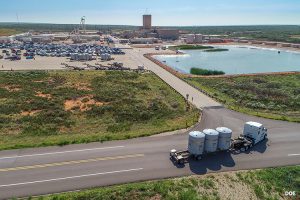 “A couple of years ago, I was asked to mediate a dispute between the U.S. Department of Energy (DOE) and the New Mexico Environment Department (NMED) concerning the renewal of a required state permit for DOE’s Waste Isolation Pilot Plant (WIPP), the nation’s only deep underground nuclear waste storage facility, located outside of Carlsbad, New Mexico. I thought I could help the two government entities but quickly came to realize that under the mediation procedures followed by New Mexico, the mediation would also involve citizen groups whose ultimate concurrence was essential to any complete resolution. This was entirely new to me.
“A couple of years ago, I was asked to mediate a dispute between the U.S. Department of Energy (DOE) and the New Mexico Environment Department (NMED) concerning the renewal of a required state permit for DOE’s Waste Isolation Pilot Plant (WIPP), the nation’s only deep underground nuclear waste storage facility, located outside of Carlsbad, New Mexico. I thought I could help the two government entities but quickly came to realize that under the mediation procedures followed by New Mexico, the mediation would also involve citizen groups whose ultimate concurrence was essential to any complete resolution. This was entirely new to me.
“In this case, there were seven such citizen groups entitled to participate and representing a variety of points of view. There was one group representing some of the government and business leaders of the town of Carlsbad who favored permit renewal on terms ensuring the continued long-term operation of WIPP. There were six groups expressing a variety of concerns about nuclear waste coming to New Mexico. They sought a more restrictive permit.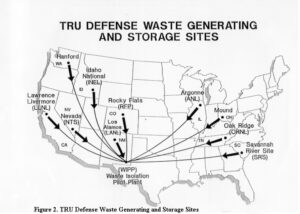
“To my astonishment, over the course of four full days, we worked through the multitude of issues and came to complete agreement. Something magical had happened. Thanks to the goodwill of the DOE and its contractor, the remarkable daily attendance and attentiveness of the NMED Secretary and the measured and well-informed way in which the various citizen groups made their points, we were able to find consensus and craft permit language that was acceptable to everyone.
“For me, as a former judge and mediator, the experience was thrilling. It was an experience of participatory democracy in action that made me proud of our fellow citizens and our government. Three aspects of the experience stand out. First, everyone in the room had taken responsibility for the way in which our nation’s only deep underground nuclear storage facility would be operated for the next 10 years. The citizen participants were not just making suggestions; they were assuming many of the attributes of decision makers. Second, all participants were advocating, compromising, and collaborating on behalf of what they saw as the public interest. These are the essential skills of democracy—the civic virtues so central to the Founders’ vision of what would make democracy work in America—and they require practice. Finally, over four days around a table, the citizens were able to take the measure of the DOE and NMED representatives. They came to realize, as I did, that these public servants, as well as the DOE contractor, were very well-informed, experienced, and intentioned. The government representatives had a similar experience of coming to appreciate the citizen questions and points of view. A government that relies on trust needs this kind of interaction to maintain that trust.
“It seems our democracy would be strengthened if we could extend the benefits of this kind of participatory structure to other areas of our legal and regulatory systems.”
“In Democracy in America, Alexis de Tocqueville made some of these points in reference to the jury trial in civil cases. He emphasized the importance of the civil jury trial as a free “public school” [https://contextus.org/Tocqueville,_Democracy_in_America_(1835),_Book_I,_Chapter_XVI_Causes_Mitigating_Tyranny_In_The_United_States_(Part_II).13?ven=Gutenberg&lang=en]  educating jurors in the democratic virtues and skills and teaching them to assume responsibility. In the same vein, every trial judge I know would attest to the importance of the jury experience for building confidence in the courts. After a trial, judges often hear words of gratitude from jurors who are deeply impressed by the legal process and are honored to have participated despite their initial dismay at being called to jury service. Sadly, the number of jury trials has diminished, particularly in federal court. Reversing that trend is a worthy goal, particularly for a branch of government that depends so heavily on public confidence.
educating jurors in the democratic virtues and skills and teaching them to assume responsibility. In the same vein, every trial judge I know would attest to the importance of the jury experience for building confidence in the courts. After a trial, judges often hear words of gratitude from jurors who are deeply impressed by the legal process and are honored to have participated despite their initial dismay at being called to jury service. Sadly, the number of jury trials has diminished, particularly in federal court. Reversing that trend is a worthy goal, particularly for a branch of government that depends so heavily on public confidence.
“As a final reflection: any persons involved as litigants will have an experience of the legal system. The experience can advance their sense of agency and participation, their ability to disagree civilly, and their trust in the courts. But how can these objectives be obtained when so many Americans cannot afford a lawyer? We can do so much better to provide understanding of and access to our justice system.”
The six New Mexico based non-governmental organizations were Citizens for Alternatives to Radioactive Dumping (CARD), Concerned Citizens for Nuclear Safety (CCNS), Conservation Voters New Mexico (CVNM), Nuclear Watch New Mexico, Southwest Alliance for a Safe Future (SAFE), and Southwest Research and Information Center (SRIC). The individual was Steve Zappe, a grandfather and former NMED WIPP Program Manager.
“A House of Dynamite” New Netflix Nuclear Catastrophe Film: Fiction, for Now
The reviews are rolling in for “A House of Dynamite,” which premiered in Europe earlier this month before coming to the U.S. on October 10th, with a full Netflix release scheduled for the 24th. Here’s the trailer, and see the schedule for Santa Fe theater showings here:
This Week! Santa Fe Theater Screenings for the Film “A House of Dynamite”
I attended one of these screenings last night, and I’ll let the professional critic reviews give the gist:
The Kathryn Bigelow thriller looks at what might happen if a ballistic missile were headed to the U.S. The director hopes the movie will start a conversation. New York Times: At Venice, ‘A House of Dynamite’ Is Scarier Than Most Horror Films
“The Netflix thriller captures from multiple perspectives the White House response to an unattributed missile launch headed for a major U.S. city in the harrowing 20 minutes until projected impact…”An unrelenting chokehold thriller so controlled, kinetic and unsettlingly immersive that you stagger out at the end of it wondering if the world will still be intact.” ‘A House of Dynamite’ Review: Idris Elba and Rebecca Ferguson in Kathryn Bigelow’s Precision-Tooled, Viscerally Unsettling Nail-Biter
“Told from the perspective of soldiers at a remote Alaskan missile base, staffers in the White House situation room, military officials at US Central Command (CENTCOM), and the president of the United States, the film weaves an overlapping timeline to show how the United States would respond to a missile attack…The film doesn’t want viewers to ask themselves how to thwart a nuclear attack on the United States. Rather, it wants the viewer to question the value of having nuclear weapons at all. ‘None of this makes sense,’ the President (Idris Elba) bemoans, ‘Making all these bombs and all these plans.'”
“A House of Dynamite is a terrifying examination of how terribly wrong things can go even with highly competent people in charge…But that’s also not necessarily the world we’re living in…The film shows why the worst can happen, even when competent, well-meaning people are trying to do the right thing.
But what if competence and decency are in short supply?” A House of Dynamite: Bigelow’s latest thriller shows why nuclear bombs are only part of the danger
This film left me reeling with tension and anxiety and exactly as the Times article titles it, is scarier than most horror films. Unlike ‘Oppenheimer,’ which largely glorified the invention of the atomic weapon, ‘A House of Dynamite’ makes it impossible to ignore the threat that nuclear weapons pose to our world. Working backwards from perspectives, and focused on how we can actually improve our odds of keeping this story a fictional one, here is what struck me most about this film:
-
-
Only one person decides what happens. But the real threat isn’t one reckless leader — it’s a reckless system. The final segment of the film features the “nuclear football” heavily, a briefcase containing launch procedures and options. In the United States, the president holds the sole and absolute authority to order the use of nuclear weapons. In the film, there are many voices in the President’s ear, but two primary perspectives quickly emerge after the defense fails and the ICBM remains inbound to its U.S. target: “One side advocates a retaliatory strike; the other, nothing. ‘It’s surrender or suicide,’ one adviser tells the President,” – thebulletin.org. The military aide carrying the nuclear football is tasked with providing the President the list of options if retaliation is chosen. An absolute must-read, Daniel Ellsberg’s book “The Doomsday Machine” breaks down many of the themes in the film with pure and terrifyingly honest account of Cold War-era nuclear strategy. In terms of launch authority, he describes how the inherent instability of the delegated command structure of the nuclear apparatus makes accidental or unwanted war an ever-present danger.
-
LANL tritium containers to head to Texas after last treatment
Four flanged tritium waste containers have been depressurized and transported to Los Alamos National Laboratory’s Weapons Engineering Tritium Facility, where they will be treated further before heading out-of-state for disposal.
By Alaina Mencinger amencinger@sfnewmexican.com | October 15, 2025 santafenewmexican.com
The containers’ final destination is Waste Control Specialists, a West Texas facility that handles the storage and disposal of radioactive waste.
The more than 1,300-acre facility in Andrews County is located on an approximately 14,000 acre property, which is sited on a thick clay formation which the company describes as “nearly impermeable.”
New documents have been added to the Los Alamos Legacy Cleanup Contract Electronic Public Reading Room.
All legacy cleanup documents required to be posted after April 30, 2018, are available on the site linked above.
For legacy cleanup documents that were posted prior to April 30, 2018, please visit the LANL electronic public reading room.
- Review, Notice of Completion of Off-Site Waste Shipments for Final Disposal, Activities 3.1.5, 3.1.8, and 3.3.4, Compliance Plan, Site Treatment Plan, Federal Facility Compliance Order Los Alamos National Laboratory [July 31, Aug. 21, 2025]
https://ext.em-la.doe.gov/GovFTPFiles/api/GetFiles/GetFile?fileName=EMID-703933_NMED_Review_STP_Shpmt_Jul_31_Aug_21_101525.pdf
Strong Political and Public Opposition Means Consolidated Interim Storage Facility (CISF) in NM “Impossible in the Near Future”
NEW UPDATE OCTOBER 10, 2025:
Holtec abandons plan to build New Mexico storage facility for spent nuclear fuel
This is excellent news. The Governor and state legislature (specifically Senator Jeff Steinborn and Representative McQueen) are to be commended for not allowing New Mexico to become the nation’s dumping ground for highly radioactive commercial spent fuel rods, especially when the Land of Enchantment has never had its own nuclear energy plant. Hard work from many New Mexicans made this happen.
So-called “interim” storage would never be interim when the federal government has failed for more than four decades to find a permanent repository for these lethal wastes. This also shows how hollow all the hype is about the claimed renaissance of nuclear power, when on the front end the industry can’t survive without taxpayer handouts, and on the back end can’t solve its radioactive waste problem.
Holtec’s quote that “New Mexico’s acquiescence is necessary” for interim storage to go forward is interesting, implying that we have to surrender as the nuclear colony that we are. Well, guess what, we didn’t surrender, and I predict you’ll see more of this. Moreover, whether you’re pro-nuclear or anti-nuclear, Holtec is an ethically questionable company, which is why the attorneys general of New Jersey and Massachusetts have sued it.
Adiós and good riddance, Holtec!
New York Times: Tax Break Scandal Leads to $5 Million Fine for N.J. Energy Company
SEE MORE:
Nuclear Weapons Issues & The Accelerating Arms Race: September 2025
Nuclear Weapons Update:
Putin has offered Trump a one-year extension of the numerical cap on strategic nuclear weapons in the new Strategic Arms Reduction Treaty which is 1,550 warheads (however, B52s are counted as one warhead while they can carry a dozen). New START expires in February 2026, which will be the first time the world will be without any nuclear arms control treaties since the mid-1970s. Trump has said it sounded like a good idea.
Note: New START ratification in 2010 provided the opportunity for Republicans in the Senate to attach the condition of $88 billion for nuclear weapons “modernization” that has since metastasized to ~$2 trillion. Nuclear disarmament must be prioritized as the ultimate goal over simply continued arms control.
A mere extension of the numerical cap would not involve Congressional ratification. The extension of New START’s numerical cap is in part to allow for a year in which to begin negotiations for a treaty replacement.
Plutonium Pit Production:
A draft plutonium pit production programmatic environmental impact statement is expected to be released next year in early 2026.
Accelerating Arms Race:
Is North Korea set to become world’s ‘fourth ICBM power’ after missile breakthrough? | Park Chan-kyong | South China Morning Post | September 11, 2025
A new era in North Korea’s missile programme may be dawning, as analysts warn of an imminent test launch of an intercontinental ballistic missile capable of carrying multiple warheads to the US mainland. Fresh from his appearance at China’s Victory Day parade in Beijing last week, North Korean leader Kim Jong-un personally oversaw the trial of a lighter, more robust solid-fuel ICBM engine, state media reported on Tuesday, touting the achievement as a “strategic” breakthrough.
Saudi Arabia signs a mutual defense pact with nuclear-armed Pakistan after Israel’s attack on Qatar | MUNIR AHMED & JON GAMBRELL | AP NEWS | September 18, 2025
DUBAI, United Arab Emirates (AP) — Pakistan’s defense minister says his nation’s nuclear program “will be made available” to Saudi Arabia if needed under the countries’ new defense pact, marking the first specific acknowledgment that Islamabad had put the kingdom under its nuclear umbrella.
Defense Minister Khawaja Mohammad Asif’s comments underline the importance of the pact struck this week between Pakistan and Saudi Arabia, which have had military ties for decades.
The move is seen by analysts as a signal to Israel, long believed to be the Middle East’s only nuclear-armed nation. It comes after Israel’s attack targeting Hamas leaders in Qatar last week killed six people and sparked new concerns among Gulf Arab nations about their safety as the Israel-Hamas war devastated the Gaza Strip and set the region on edge.
Russia suspected of helping North Korea build nuclear submarines, Seoul investigating | Park Chan-kyong | South China Morning Post | September 18, 2025
South Korea is investigating reports that Russia has supplied North Korea with nuclear submarine reactor modules, a move analysts see as highly plausible and one that could mark a breakthrough in Pyongyang’s decades-long push for a nuclear-powered navy… At the 8th Party Congress in January 2021, North Korea declared five core defence goals, including the development of nuclear-powered submarines and submarine-launched strategic nuclear weapons.
China Hardens Military Stance Against U.S. With Nuclear Weapons and Tough Talk | Brian Spegele | The Wall Street Journal| September 18, 2025
China played down its rapidly rising military might for years. In the past few weeks, Beijing has broadcast a steady drumbeat of firepower displays and muscular rhetoric, carrying an unmistakable warning for the U.S… Part of China’s confidence stems from the rapid growth of its firepower. The Pentagon estimates that China’s stockpile of nuclear warheads has more than doubled since 2020, alongside a growing array of options to launch those weapons, from mobile ground-launch systems to increasingly stealthy submarines.
Holtec Pulls Out of New Mexico Spent Nuclear Fuel Interim Storage Project
Holtec International has confirmed it is canceling plans to build a consolidated interim storage facility for spent nuclear fuel in southeastern New Mexico.
By Radwaste Solutions | October 9, 2025 ans.org
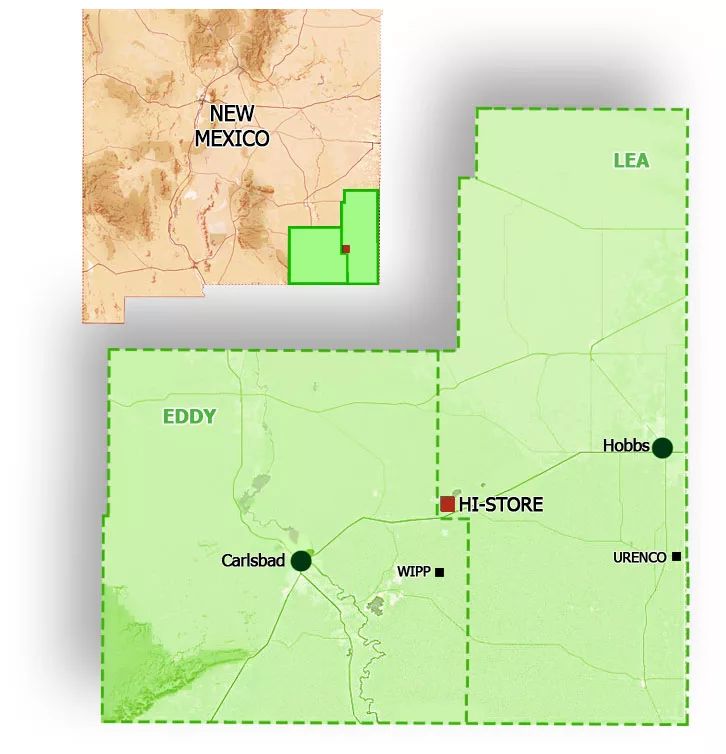
Named the HI-STORE CISF, the facility would have stored up to 10,000 canisters of commercial SNF on land owned by the Eddy-Lea Energy Alliance (ELEA) near the towns of Carlsbad and Hobbs.
“After discussions with our longtime partner in the HI-STORE project, the Eddy-Lea Energy Alliance, and due to the untenable path forward for used fuel storage in New Mexico, we mutually agreed upon canceling the agreement. This allows for ELEA to work to redevelop the property in a manner that fits their needs and allows Holtec to work with other states who are amenable to used fuel storage based on the recent DOE work on public education and outreach,” Holtec said in a statement (emphasis added).
Following the U.S. Supreme Court’s June ruling in NRC v. Texas, which found that petitioners did not have standing to challenge the Nuclear Regulatory Commission’s licensing of Interim Storage Partners’ CISF in Texas, Holtec said it expected to have its HI-STORE CISF license reinstated, allowing the company to move forward with the project. Holtec and ISP’s NRC licenses were vacated by the 5th Circuit Court of Appeals in a 2023 ruling.
Despite the court’s decision, New Mexico Gov. Michelle Lujan Grisham said she remained committed to preventing the HI-STORE CISF from being built. In 2023, New Mexico passed a bill barring the storage and disposal of high-level radioactive waste in New Mexico without the state’s explicit consent.
The AI Doomsday Machine Is Closer to Reality Than You Think
“Most troubling to experts on AI and nuclear weapons is that it’s getting harder and harder to keep decisions about targeting and escalation for nuclear weapons separate from decisions about conventional weapons.”
“There is no standing guidance, as far as we can tell, inside the Pentagon on whether and how AI should or should not be integrated into nuclear command and control and communications,” says Jon Wolfsthal, director of global risk at the Federation of American Scientists.
By Michael Hirsh | September 2, 2025 politico.com
Jacquelyn Schneider saw a disturbing pattern, and she didn’t know what to make of it.
Last year Schneider, director of the Hoover Wargaming and Crisis Simulation Initiative at Stanford University, began experimenting with war games that gave the latest generation of artificial intelligence the role of strategic decision-makers. In the games, five off-the-shelf large language models or LLMs — OpenAI’s GPT-3.5, GPT-4, and GPT-4-Base; Anthropic’s Claude 2; and Meta’s Llama-2 Chat — were confronted with fictional crisis situations that resembled Russia’s invasion of Ukraine or China’s threat to Taiwan.
Director Kathryn Bigelow is Sounding the Nuclear Alarm – Washington Post New Review
“A House of Dynamite” asks: How would the White House respond in the face of a nuclear attack?
By Max Boot | October 2, 2025 washingtonpost.com
VIEW MORE: “A House Of Dynamite” Q&A w/ Director Kathryn Bigelow, Tracy Letts, Jared Harris, And More At New York Film Fest —
80th Commemorations of Ban the Bomb – Trinity, Hiroshima & Nagasaki Remembrances in New Mexico
Exchange Monitor: DNFSB makes agency fixes, but needs members, GAO finds
The Defense Nuclear Facilities Safety Board (DNFSB) has tackled all but a few third-party recommendations to improve its culture over the past decade but suffers from a depleted board, according to a new report.
By ExchangeMonitor | September 5, 2025 santafenewmexican.com
Progress is tough with the five-person board probably…
China Hardens Military Stance Against U.S. With Nuclear Weapons and Tough Talk
Xi positions Beijing as powerful center of new global order as security forum convenes in capital
By Brian Spegele | September 18, 2025 wsj.com
BEIJING—China played down its rapidly rising military might for years. In the past few weeks, Beijing has broadcast a steady drumbeat of firepower displays and muscular rhetoric, carrying an unmistakable warning for the U.S….
Saudi Arabia signs a mutual defense pact with nuclear-armed Pakistan after Israel’s attack on Qatar
While not specifically discussing the bomb, the agreement states “any aggression against either country shall be considered an aggression against both,” according to statements issued by both Pakistan’s Foreign Affairs Ministry and the state-run Saudi Press Agency.
By MUNIR AHMED and JON GAMBRELL | September 18, 2025 apnews.com
ISLAMABAD (AP) — Saudi Arabia and nuclear-armed Pakistan have signed a mutual defense pact that defines any attack on either nation as an attack on both — a key accord in the wake of Israel’s strike on Qatar last week.
The kingdom has long had close economic, religious and security ties to Pakistan, including reportedly providing funding for Islamabad’s nuclear weapons program as it developed. Analysts — and Pakistani diplomats in at least one case — have suggested over the years that Saudi Arabia could be included under Islamabad’s nuclear umbrella, particularly as tensions have risen over Iran’s atomic program.
COMMUNITIES FOR CLEAN WATER: LANL Radioactive Tritium Venting Fails to Provide Transparency, Assurance, and Respect for Local Communities
FOR IMMEDIATE RELEASE: September 18, 2025
Santa Fe, NM — As NNSA and LANL continue operations to depressurize Flanged Tritium Waste Containers, Communities for Clean Water (CCW) calls out federal agencies for issuing vague assurances instead of transparent, verifiable data — and for dismissing community concerns with contradictory and incomplete statements that disregard what independent experts have found, the Department of Energy’s (DOE) own legal obligations, and the New Mexico Environment Department’s (NMED) acknowledgment that LANL has a long record of compliance failures.
“How can our communities be expected to trust LANL when they won’t give us access to the raw, real-time monitoring data – independently verified by the EPA,” asks Joni Arends with Concerned Citizens for Nuclear Safety. “Without this transparency, LANL is continuing a legacy of empty assurances, not accountability.”
Key Concerns:
-
Lack of real-time transparency – Since Friday (Sept. 12), the public has been forced to rely on NMED’s Facebook page for piecemeal updates. While LANL’s website provides very brief daily summaries, no near-real-time monitoring dashboard from DOE, NNSA, or LANL has been made available.
-
Vague assurances, not real information – NNSA’s updates claim “no tritium was released” while simultaneously telling the public to expect “very low levels of tritium” for subsequent venting. Without numbers, monitoring data, or detection thresholds, these phrases do not provide reassurance.
-
Weather risks – LANL has not disclosed thresholds for wind, rain, or humidity that would postpone venting. Communities watch weather shifts in real time but are left in the dark about how safety decisions are being made.
-
Dismissal of public health concerns – When asked for plain-language guidance that NMED stated LANL would provide, LANL responded only with “no offsite impact anticipated.” This is not meaningful and reassuring guidance, it’s a blanket dismissal that disregards independent expert findings and fails to meet DOE’s obligations to protect vulnerable populations.
-
Ignoring daily lifeways – Avoiding Pueblo Feast Days is not enough. This is harvest season, when outdoor cultural events, youth programs, and farming are in full swing. LANL’s scheduling continues to disregard these realities.
Unanswered Questions
Independent experts and community advocates have raised critical unanswered questions:
-
Unclear “depressurization” – LANL said “no internal pressure was found” in a container, but also claimed it was “depressurized.” If no pressure existed, what was released?
-
Unanswered helium questions – NMED stated helium was released, but LANL has not explained its origin. Was it introduced at sealing of the outer container, or a decay product of tritium?
-
Monitoring limits undisclosed – LANL has not disclosed the detection limits of its monitoring equipment. Readings “indistinguishable from zero” could still mask releases.
DOE NNSA Gives Misleading Statements on Native America Calling
On a recent Native America Calling program, DOE NNSA’s Los Alamos Field Office Deputy Director Pat Moss compared LANL venting to global natural tritium stocks. Independent expert Dr. Arjun Makhijani pointed out this comparison as misleading: “The problem is not global background, but local contamination. If venting occurs in rain and calm winds, local rainfall could exceed U.S. drinking water standards by hundreds to thousands of times.”
In their most recent public meeting, LANL admitted that infants could receive three times the radiation dose as adults. During the interview, Dr. Makhijani pressed this point – if adults are modeled at 6 mrem, that means infants could be at 18 mrem, nearly double the EPA’s 10 mrem compliance limit. Instead of addressing this directly, Mr. Moss provided a stock line, “We will be compliant with the regulatorily imposed release threshold and will be doing the calculations per the regulation.”
That is exactly the problem – hiding behind regulatory caps while ignoring clear evidence that infants, our most vulnerable, face exposures above legal limits.
DOE NNSA also pointed to the Defense Nuclear Facilities Safety Board (DNFSB) – an independent federal oversight body created by Congress – as if it had declared the tritium venting operation as “fully protective of the public”. That is misleading. First, the DNFSB has been operating without a quorum for months, limiting its ability to issue independent recommendations. Second, what the Board staff said in its July 2025 presentation was that the overall nuclear safety risk to the public is low if DOE’s proposed controls are followed. The DNFSB has also flagged ongoing safety concerns at LANL including deficiencies in Area G’s safety analysis and risk to workers.
First of four containers of tritium waste at LANL has been vented
The first of four flanged tritium waste containers awaiting removal from Los Alamos National Laboratory has been vented, the New Mexico Environment Department announced Tuesday afternoon.
By Alaina Mencinger amencinger@sfnewmexican.com | September 16, 2025 santafenewmexican.com
The container can now be moved for treatment at LANL and then, eventually, to an off-site disposal area.
No internal pressure was found in the first container, according to the National Nuclear Security Administration, suggesting the inner containers in the flanged tritium waste container hadn’t leaked. Air monitoring did not show an increase of tritium beyond background levels, the federal agency wrote.
No tritium emissions were released, the Environment Department wrote in its Tuesday post on X, formerly Twitter. Both the state agency and the U.S. Environmental Protection Agency are monitoring the process.
The depressurization of the containers is set to continue at 7 a.m. Wednesday, although the NNSA noted the schedule is subject to change due to weather. The four containers will be vented one at a time over an estimated two-week period.
*The featured image differs from the article photo due to usage rights.
New Mexicans Can Save the DNFSB; Contact Our Senators Today
From our friends at Concerned Citizens for Nuclear Safety:
The independent Defense Nuclear Facilities Safety Board has been dwindling from a five-member board to one member and may disappear if we, the People, do not raise our voices to support its essential nuclear safety work. The Safety Board needs at least two new members. And that needs to get done by Saturday, October 18th. https://www.dnfsb.gov/about
New Mexico U.S. Senators Heinrich and Lujan have key roles to play to ensure the Safety Board’s work continues unimpeded. https://www.heinrich.senate.gov/ and https://www.lujan.senate.gov/ Our voices of support are essential to ensure communities continue to receive the essential services of the Safety Board and its staff.
Right now members of the Safety Board’s staff are monitoring the venting of radioactive tritium from Area G at Los Alamos National Laboratory (LANL). Their expertise in the field of nuclear safety and their demonstrated competence and knowledge relevant to their independent investigative and oversight functions are an essential part of the process. They will be part of the follow-up once the venting of the four flanged tritium waste containers is completed. https://tewawomenunited.org/?s=tritium, https://www.ccwnewmexico.org/tritium, https://nuclearactive.org/
Not only does the Safety Board have staff at LANL, but also at Sandia National Laboratories in Albuquerque and at the Waste Isolation Pilot Plant, the burial site for plutonium contaminated nuclear weapons waste, near Carlsbad. https://ananuclear.org/facilities/
Russia suspected of helping North Korea build nuclear submarines, Seoul investigating
Analysts said such a technology transfer was plausible given Pyongyang’s support for Russia’s ongoing war in Ukraine
By Park Chan-kyong | September 18, 2025 scmp.com
South Korea is investigating reports that Russia has supplied North Korea with nuclear submarine reactor modules, a move analysts see as highly plausible and one that could mark a breakthrough in Pyongyang’s decades-long push for a nuclear powered navy…
Holy See tells nations at UN to end threat of nuclear weapons, even as deterrence
Amid a global arms race, ending the threat of nuclear war — and even the testing of nuclear weapons — is imperative, said the Holy See’s diplomat to the United Nations.
By Gina Christian, OSV News | September 8, 2025 catholicreview.org
Archbishop Gabriele G. Caccia, the Holy See’s U.N. permanent observer, shared his thoughts in a statement he delivered Sept. 4 at U.N. headquarters in New York, during the General Assembly High-level Plenary Meeting to Commemorate and Promote the International Day Against Nuclear Tests, observed that same day.
“The pursuit of a world free of nuclear weapons is not only a matter of strategic and vital necessity, but also a profound moral responsibility,” Archbishop Caccia in his remarks.
He pointed to the introduction of nuclear weapons — first detonated by the U.S. in 1945 over the Japanese cities of Hiroshima and Nagasaki, killing an estimated 110,000 to 210,000 people, during World War II — as unveiling to the world “an unprecedented destructive force.”
Historic peace vigil partially dismantled after Trump orders: ‘Take it down’
Law enforcement officials on Sunday removed parts of the White House Peace Vigil, which has sat just outside the White House for decades.
By Marissa J. Lang, The Washington Post | September 8, 2025 washingtonpost.com
But over the past week, it faced a new threat as Trump turned his attention to the vigil and federal officers picked apart the structure that shields protesters and their signs from the elements. The vigil is maintained by a rotating cast of volunteers who keep the protest going 24 hours a day, seven days a week.
On Friday, Brian Glenn, a correspondent for the conservative network Real America’s Voice, told the president during a gathering with reporters that there was “a blue tent” in front of the White House that was “an eyesore.” Trump initially said he was unaware of it, but he then quickly ordered its removal.
Photo by Sig. Chiocciola, Creative Commons: The White House Peace Vigil on March 30, 2025 staffed by volunteers, Philipos Melaku-Bello (left) and Joe Brown (right).
For 80 years, nuclear weapons have been the unused threat
Amid a global arms race, ending the threat of nuclear war — and even the testing of nuclear weapons — is imperative, said the Holy See’s diplomat to the United Nations.
By Matt Kelly, mkelly@virginia.edu, September 3, 2025 news.virginia.edu
In the 80 years since World War II, which ended with the use of two atomic bombs, the world has maintained a tenuous relationship with nuclear weapons.
Philip Potter, professor of public policy at the University of Virginia’s Frank Batten School of Leadership and Public Policy and director of the National Security Data and Policy Institute, said he worries about the current delicate nuclear balance.
“Eighty years of non-use is the product of both good diplomacy and a recognition of the potential consequences,” Potter said. “The fearsome power of nuclear weapons causes countries pause before they use them, but a great deal of work has also gone into nonproliferation and the management of crises to keep them away from the nuclear brink. In some ways the dynamics of the Cold War made managing the potential for nuclear confrontation easier.”
It’s a very different strategic scenario now, where there are nine nuclear powers and less capacity to manage them.
Nuclear News Archive – 2022
Unknown Impact: County asks Los Alamos National Labs to assess environmental impact before expanding nuclear production
Santa Fe County wants Los Alamos National Laboratories to take stock of its impact on the environment and surrounding communities before pushing ahead with plans to expand.
By Leah Cantor | sfreporter.com Jan 27, 2021
On Tuesday, the Board of County Commissioners unanimously passed a resolution asking the National Nuclear Safety Administration to complete a new site-wide environmental impact statement for LANL in compliance with the National Environmental Policy Act before expanding plutonium pit production.
“The public health and safety is so important,” said Commissioner Anna Hansen, noting that the NEPA process is one of the only avenues for the public to weigh in on what goes on at the labs. “We have a longstanding tradition of promoting democracy and environmental protection in impending nuclear weapons by requesting that local governments be kept fully informed about projects to facilitate large scale production of additional plutonium warheads,” she said.
Yet right now, the labs’ full impact on Northern New Mexico is unknown. It’s been more than a decade since the last time the NNSA produced an EIS for the laboratory, and a lot has changed since then, including regional understanding of wildfire risks and potential water contamination from the labs.
Remembering the Night Two Atomic Bombs Fell—on North Carolina
Sixty years ago, at the height of the Cold War, a B-52 bomber disintegrated over a small Southern town. An eyewitness recalls what happened next.
By: Bill Newcott | nationalgeographic.com PUBLISHED JANUARY 22, 2021
BILLY REEVES REMEMBERS that night in January 1961 as unseasonably warm, even for North Carolina. But it got a lot hotter just before midnight, when the walls of his room began glowing red with a strange light streaming through his window.
“I was just getting ready for bed,” Reeves says, “and all of a sudden I’m thinking, ‘What in the world…?'”
The 17-year-old ran out to the porch of his family’s farm house just in time to see a flaming B-52 bomber—one wing missing, fiery debris rocketing off in all directions—plunge from the sky and plow into a field barely a quarter-mile away.
“Everything around here was on fire,” says Reeves, now 78, standing with me in the middle of that same field, our backs to the modest house where he grew up. “The grass was burning. Big Daddy’s Road over there was melting. My mother was praying. She thought it was the End of Times.”
Like any self-respecting teenager, Reeves began running straight toward the wreckage—until it exploded.
The Doomsday Datavisualizations



In setting the Doomsday Clock, the Bulletin’s Science and Security Board consults widely with colleagues across a range of disciplines and considers qualitative and quantitative information from a wide array of sources. These three visualizations display some of the kinds of public data that are available in the Bulletin’s three coverage areas: nuclear weapons, climate change, and disruptive technology.
The Doomsday Clock is a design that warns the public about existential threats, a metaphor that reminds the world of the perils that must be addressed if humanity is to continue survive. These three data visualizations can be seen as an artistic extension of the original design.
DESIGNED BY PENTAGRAM
Giorgia Lupi, Sarah Kay Miller, Phil Cox,
Ting Fang Cheng, Talia Cotton
In November 2011, the U.S. Senate designated January 27th as a National Day of Remembrance for the Nevada Test Site Downwinders. The Senate recognized the harm caused to Americans from radioactive fallout from the aboveground atomic tests in Nevada, which began on January 27, 1951 and ended on July 17, 1962. Nuclear testing by the U.S. government started in New Mexico with Trinity in July 1945, and the Crossroads Series of three tests followed in the Pacific in 1946. The United States took part in nuclear testing as part of the escalating Cold War arms race, and nuclear weapons proliferated. With each nuclear test, radioactive fallout spread globally.
FOR MORE INFORMATION VIEW LINKS BELOW
Downwinders And The Radioactive West Premieres January 27 at 7PM on PBS Utah
Why a National Day of Remembrance for Downwinders is Not Enough
Congress Introduces Legislation to Expand Compensation for Radiation Exposure
Why a National Day of Remembrance for Downwinders is Not Enough
“A day of recognition is important – these communities deserve to be recognized for the unimaginable sacrifice they unknowingly made to their country. But it is not enough. The best and most important way to honor these victims of the US nuclear weapons program is by compensating them and providing health care for the illnesses and deaths they have suffered.”
BY: LILLY ADAMS GUEST COMMENTARY, UCS | JANUARY 26, 2021, 10:56 AM EST
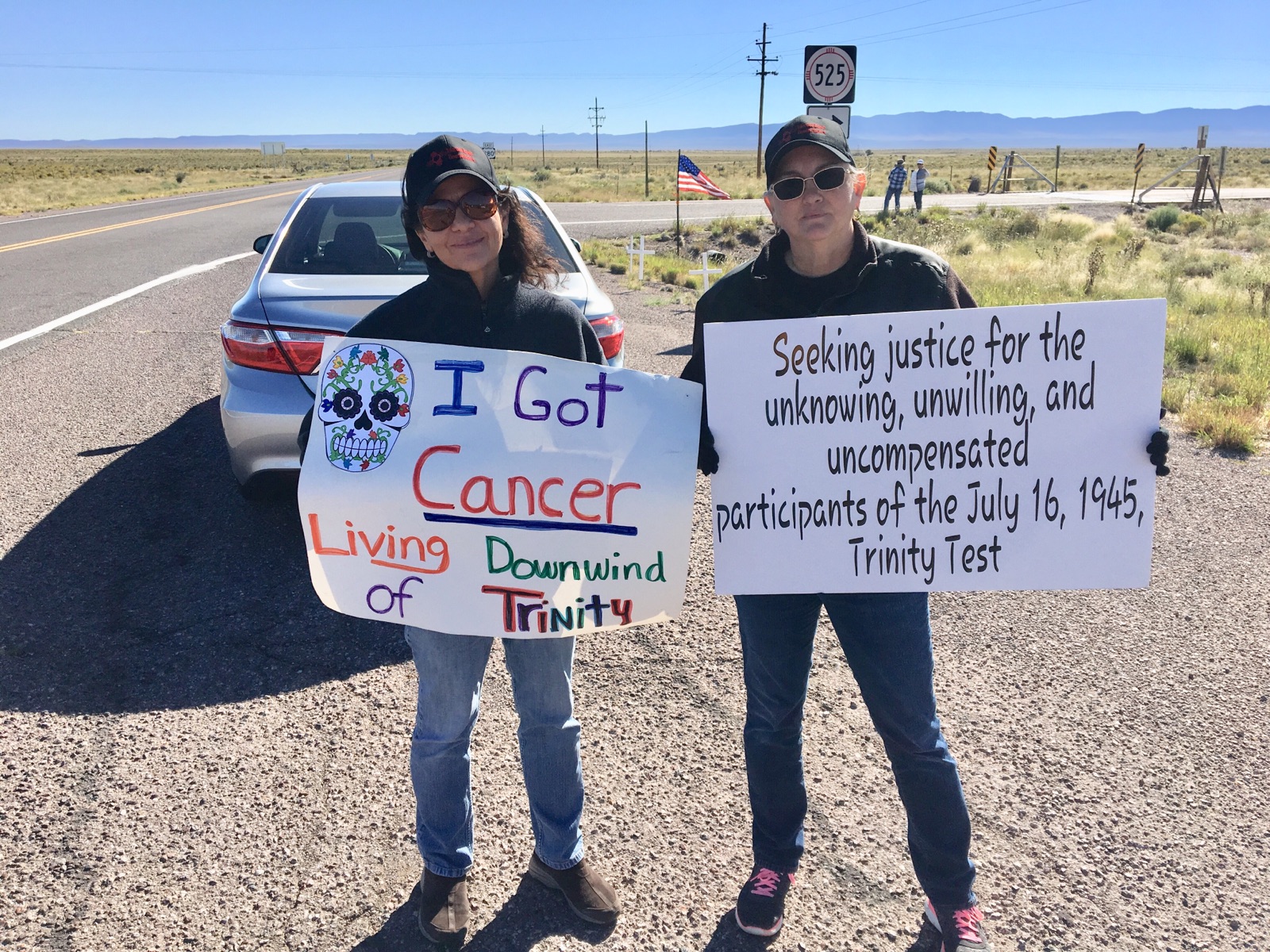
There’s no question that the US government killed and sickened many of its own people through explosive nuclear testing: estimates of the death toll in the United States from nuclear testing vary widely, from tens of thousands to hundreds of thousands. But the harm doesn’t stop there. Other nuclear weapons activities, like uranium mining, production, and waste storage and cleanup, have also caused unknown deaths and illnesses. As is so often the case, the people who have borne the heaviest burden of these activities are often people of color, Indigenous communities, women and children, and those living in poor, rural communities. These people are the largely ignored, often forgotten casualties of the Cold War and the US nuclear weapons program.
The Most Dangerous Situation Humanity Has Ever Faced
“The Bulletin of the Atomic Scientists announced Wednesday that the hands of the iconic Doomsday Clock remain at 100 seconds to midnight — as close to the end of humanity as the clock has ever been. The temptation, of course, in a dark hour is to cling to even the faintest signs of light and hope. And the truth is that there are some encouraging signs now emerging. However, we continue to teeter at the brink and moving the Clock away from midnight would provide false hope at a time when urgent action is what is needed.”.
Opinion by Edmund G. Brown Jr. and Robert Rosner / Updated 11:17 AM ET, Wed January 27, 2021
For a year now, the world has been ravaged by the horrors of Covid-19. It has caused millions to lose their jobs, overwhelmed health care systems and dramatically changed how we live. The disease has killed more than 2 million people and infected 100 million around the globe.
Even so, we face fundamentally greater threats to humanity than this pandemic. We refer to the catastrophic dangers which nuclear weapons and climate change pose — dangers that preceded this pandemic and will persist long after it ends. Unfortunately, and unlike the priority given to developing a vaccine against the virus, little progress was made to reduce the danger of the world’s nuclear weapons arsenal or to effectively slow the carbon emissions warming our planet in 2020. The sudden appearance and confused response to the virus makes all too clear how ill-prepared the world can be when it has to deal with an unprecedented threat of global magnitude.
UN Building Lit Up to Celebrate The Nuclear Ban Treaty Entry Into Force January 22





Here are five examples of the type of activities that will be Illegal under international law on 22 January 2021
One of the main problems with talking about nuclear weapons is that it often becomes abstract and hypothetical. Most people barely know which countries have nuclear weapons and do not know to what extent other actors are involved in maintaining and upholding nuclear weapons.
When the Treaty on the Prohibition of Nuclear Weapons (TPNW) enters into force on 22 January 2021, that will need to change.
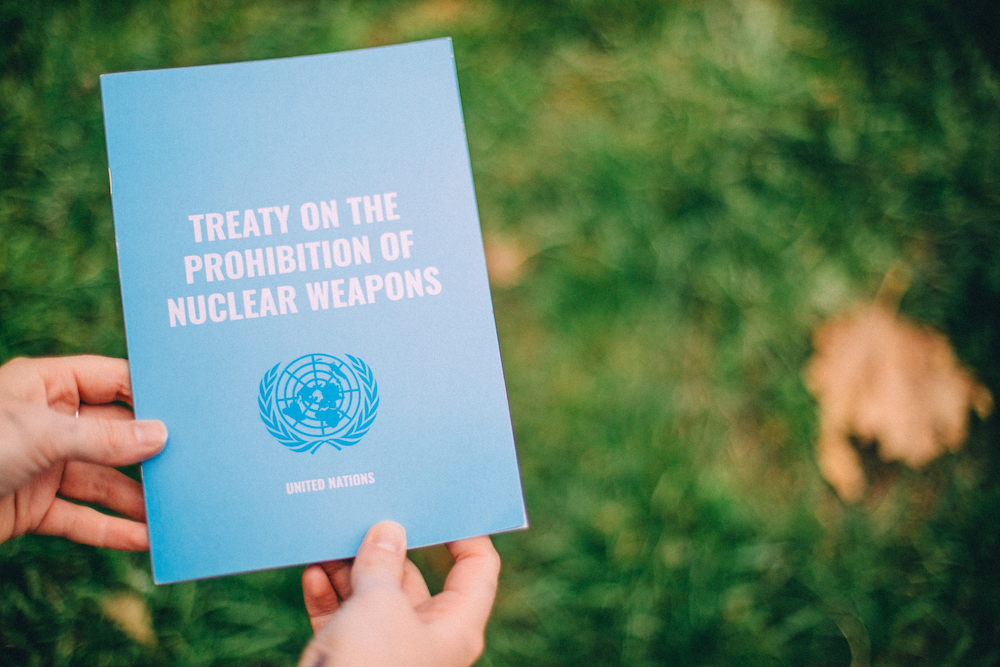
Here are five examples of the kind of activities that will be prohibited under the TPNW and who is currently doing this today. While the treaty will only be legally binding in the countries that have ratified the treaty, it will still create a powerful norm and should lead to increased protests and outrage in countries that haven’t joined the treaty that are behaving in contradiction of this new instrument of international law.
What the treaty prohibits
Article 1 of the treaty prohibits states parties from developing, testing, producing, manufacturing, transferring, possessing, stockpiling, using or threatening to use nuclear weapons, or allowing nuclear weapons to be stationed on their territory. It also prohibits them from assisting, encouraging or inducing anyone to engage in any of these activities.
Treaty Seeks End to Nuclear Madness
It is the beginning of a new movement that will see the elimination of the existential nuclear threat.
Ralph Hutchison, John LaForge | progressive.org
On January 22, the Treaty on the Prohibition of Nuclear Weapons will enter into force. The treaty bans the development, production, possession, deployment, testing, use and just about anything else you can imagine related to nuclear weapons.
Fifty years later, nine nuclear-armed militaries possess more than 13,000 nuclear weapons, arsenals that mock their claimed commitment to disarm “at an early date.”
Approved at the United Nations by 122 countries in 2017, and subsequently signed by 86 and ratified by 51 nations, the nuclear weapons ban will join the venerated status of international prohibitions already established against lesser weapons of mass destruction. These earlier agreements include the Geneva Gas Protocol, the Chemical Weapons Convention, the Biological Weapons Convention, the Ottawa Treaty or Mine Ban Convention and the Convention on Cluster Munitions.
Atop the Powerful Budget Committee at Last, Bernie Sanders Wants to Go Big
To the chagrin of Republicans, the democratic socialist senator will play a central role in shepherding Joseph R. Biden Jr.’s agenda through Congress.
“Sanders, the next chairman of the Senate Budget Committee, plans to take a hard look at fraud at the defense budget in his new perch, he tells POLITICO
“You understand you’re talking to the guy who led the effort to lower defense spending by 10 percent,” the Vermont Independent and self-described Democratic Socialist boasted.
You’re talking about the military budget, which is now higher than the next 10 nations combined,” he continued. “You’re talking about the Pentagon budget, which is the only major government agency which has not been able to undertake an independent audit. And I don’t think anyone has any doubt that there’s massive waste and cost overruns in the military budget.”
“I think if you check the record,” he added, “you’ll find that every major defense contractor has been found guilty of collusion and fraud.”
By Alan Rappeport and Jim Tankersley | nytimes.com
Shortly before the 2016 election, Paul D. Ryan of Wisconsin, the Republican nominee for vice president and the speaker of the House, told a group of college Republicans why he thought Democrats winning control of the Senate would be a policy nightmare.
“Do you know who becomes chair of the Senate Budget Committee?” Mr. Ryan asked. “A guy named Bernie Sanders. You ever heard of him?”
Republicans have long feared the prospect of Mr. Sanders, a self-described democratic socialist from Vermont, taking the helm of the powerful committee given his embrace of bigger government and more federal spending with borrowed money. With Democrats reclaiming the Senate, that fear is about to become a reality. Mr. Sanders, the most progressive member of the chamber, will have a central role in shaping and steering the Democrats’ tax and spending plans through a Congress that they control with the slimmest of margins.
Concern grows over massive US cyberattack – New Mexico’s national labs, Los Alamos and Sandia, cited as possible targets among many
Jay Coghlan, executive director of Nuclear Watch New Mexico, said the breach escalates the threat of a nuclear catastrophe.
“On top of the dangers that we faced during the Cold War this now raises new concerns…Could our nuclear weapons be hacked for malicious reasons? Could hackers take advantage of LANL’s checkered safety and security record and cause a life threatening event in our own backyard? The sooner we all have a nuclear weapons-free world the safer we will be.”
Copyright © 2020 Albuquerque Journal / BY: T.S. LAST / JOURNAL NORTH
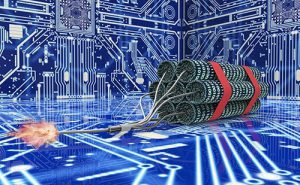 SANTA FE — While the Department of Energy says that a cyberoffensive was limited to business networks, concerns remain about the depth of the breach and what threat it could still pose to national security and New Mexico’s two national laboratories.
SANTA FE — While the Department of Energy says that a cyberoffensive was limited to business networks, concerns remain about the depth of the breach and what threat it could still pose to national security and New Mexico’s two national laboratories.
Some news reports say that the hacks are believed to have been instigated by a Russian intelligence agency. The reports specifically mention Los Alamos and Sandia national laboratories, where atomic research is conducted, as being vulnerable.
In addition, Los Alamos National Laboratory is tasked with producing plutonium pits, the triggering device in nuclear warheads.
Earlier this week the Cybersecurity and Infrastructure Security Agency (CISA) issued a warning, calling the hack “a grave risk” to federal, state, local and tribal governments, as well as critical infrastructure entities and private sector businesses. It said the suspected breach dates back to at least March.
In a joint statement this week, CISA, the FBI and the director of national intelligence said they were working together to investigate a “significant ongoing cybersecurity campaign.”\
‘Highly skeptical’: House Armed Services chairman concerned about SRS pit production
Biden administration expected to take ‘critical look’ at next-generation warhead, estimated to be twice as explosive as Trident
By: Colin Demarest cdemarest@aikenstandard.com / postandcourier.com

Photo courtesy of High Flyer
Likening the conversion of the failed Mixed Oxide Fuel Fabrication Facility to flipping a bowling alley into a restaurant, U.S. Rep. Adam Smith said he was “highly skeptical that they’re going to be able to turn that building into an effective pit production facility. Highly skeptical.”
US Nuclear Warhead Standoff ‘Has Significant Implications for UK’
Biden administration expected to take ‘critical look’ at next-generation warhead, estimated to be twice as explosive as Trident
By: Dan Sabbagh / theguardian.com

Britain’s most senior defence official admitted there would be “very significant implications” for the future of the Trident nuclear deterrent if Democrats in the US Congress refused to fund a next-generation warhead.
Sir Stephen Lovegrove, permanent secretary at the Ministry of Defence, said that the UK was monitoring the US standoff closely but could not say what impact a refusal to start work on the new W93 warhead would have – or how many billions it would cost.
THE SOFTENING RHETORIC BY NUCLEAR-ARMED STATES AND NATO ALLIES ON THE TREATY ON THE PROHIBITION OF NUCLEAR WEAPONS
BY: TOM SAUER & CLAIRE NARDON / warontherocks.com
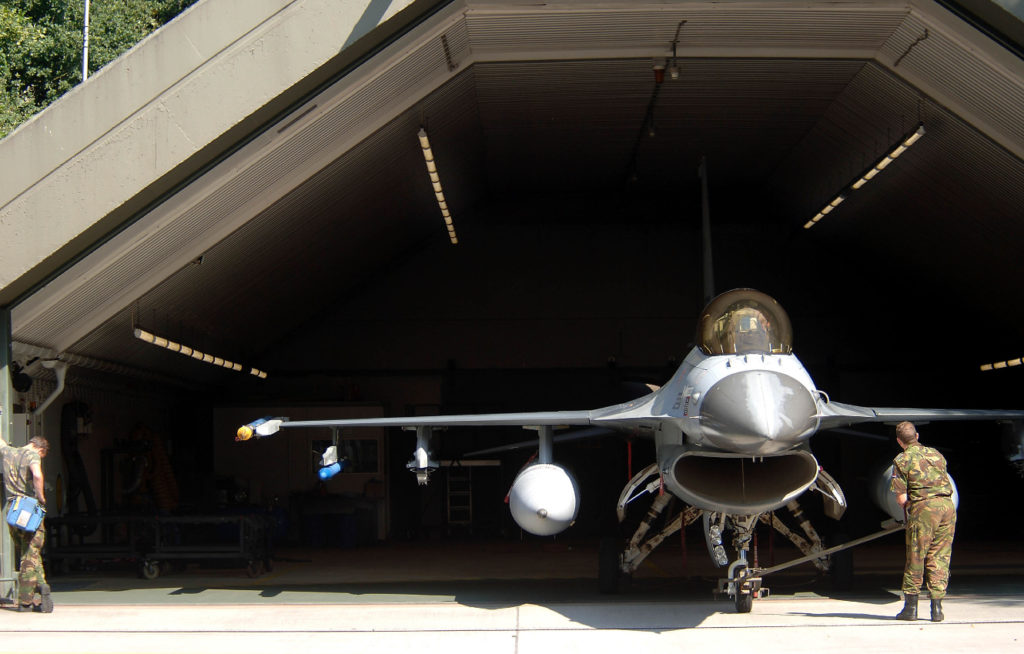
Probably the most iconic moment during the negotiations on the Treaty on the Prohibition of Nuclear Weapons (or “nuclear ban treaty”) was the gathering of a dozen allied ambassadors standing around U.S. Ambassador Nikki Haley in the corridors of the U.N. building in New York, protesting against the ongoing negotiations. While nuclear-armed states and NATO allies remain opposed to the treaty, the tone is softening, and at least two NATO allies are breaking the consensus.
Bombs Away: Weapon Systems That Biden Administration Could Curtail or Retire
Here are some of weapons that might be reviewed by the president-elect
By: Michael R. Gordon | Wall Street Journal

President-elect Joe Biden has said that he will reduce “excessive” expenditures on nuclear modernization. The Congressional Budget Office estimated in 2017 that the Pentagon’s plans for updating and sustaining the nuclear triad of air, sea and land-borne weapons would cost $1.2 trillion, and some lawmakers say the eventual cost might exceed $1.5 trillion. Here are some of the weapons that might be reviewed.
Continue reading
DOE Publishes Reactor Impact Statement
“Given that no clear mission need has been established for the VTR and with an estimated price tag of $3 billion to $6 billion, with completion ranging from 2026 to 2030, it is doubtful if the project will go forward..Just as for other costly, complex DOE projects, the price tag is certain to grow and the schedule certain to slip if the project is pursued.” — Savannah River Site Watch
By: NATHAN BROWN nbrown@postregister.com
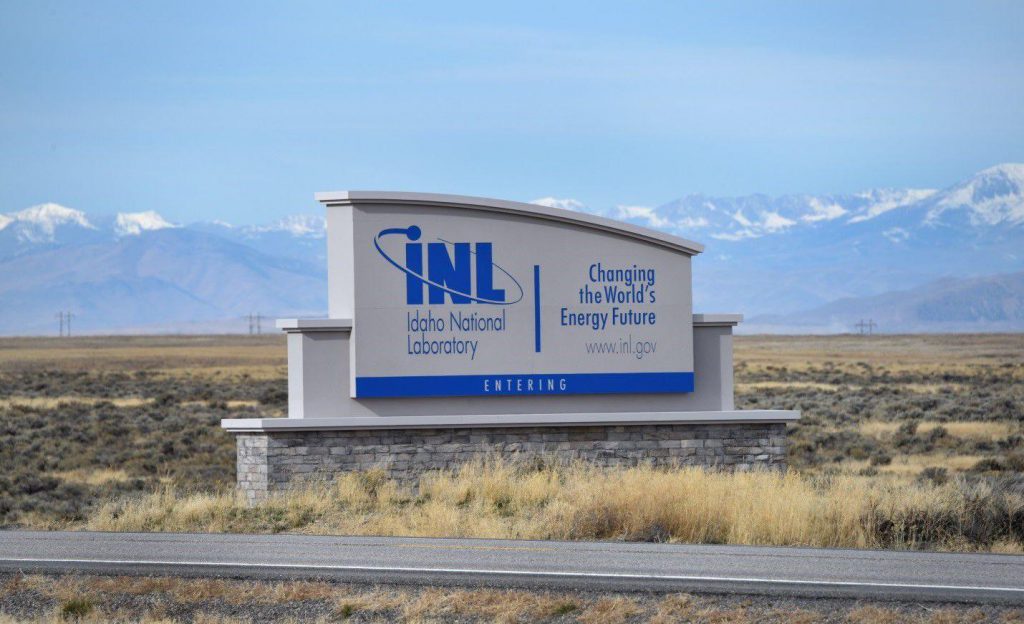
The U.S. Department of Energy has released the draft environmental impact statement for a test reactor it would like to build at Idaho National Laboratory.
The statement on the Versatile Test Reactor was released Monday and is available online through the Office of Nuclear Energy’s website, energy.gov/ne/office-nuclear-energy. Public comment will conclude 45 days after the federal Environmental Protection Agency publishes notice in the Federal Register, which is expected to happen on Dec. 31. DOE will then hold two virtual public hearings, dates to be announced.
Continue reading
DOE Awards Savannah River National Laboratory Management and Operating Contract
Cincinnati – Today, the U.S. Department of Energy (DOE) Office of Environmental Management (EM) awarded the Savannah River National Laboratory (SRNL) Management and Operating (M&O) contract to Battelle Savannah River Alliance, LLC (BSRA) of Columbus, OH.
The Cost-Plus-Award-Fee contract will include a 5-year base period (inclusive of 120 day transition period) and potential award terms of up to 5 more years, for a total period of up to 10 years. The anticipated contract value is approximately $3.8 billion over the potential 10-year period of performance.
The procurement was competed as a full-and-open competition, and EM received three proposals. The Department determined the BSRA proposal provided the best value to the Government considering Laboratory Vision, Key Personnel, Management and Operations, Past Performance, Transition Plan, and Cost and Fee.
Actual amount of radioactive contamination caused by the March 2011 Fukushima Daiichi Nuclear Power Plant accident, as revealed by Japanese citizen scientists
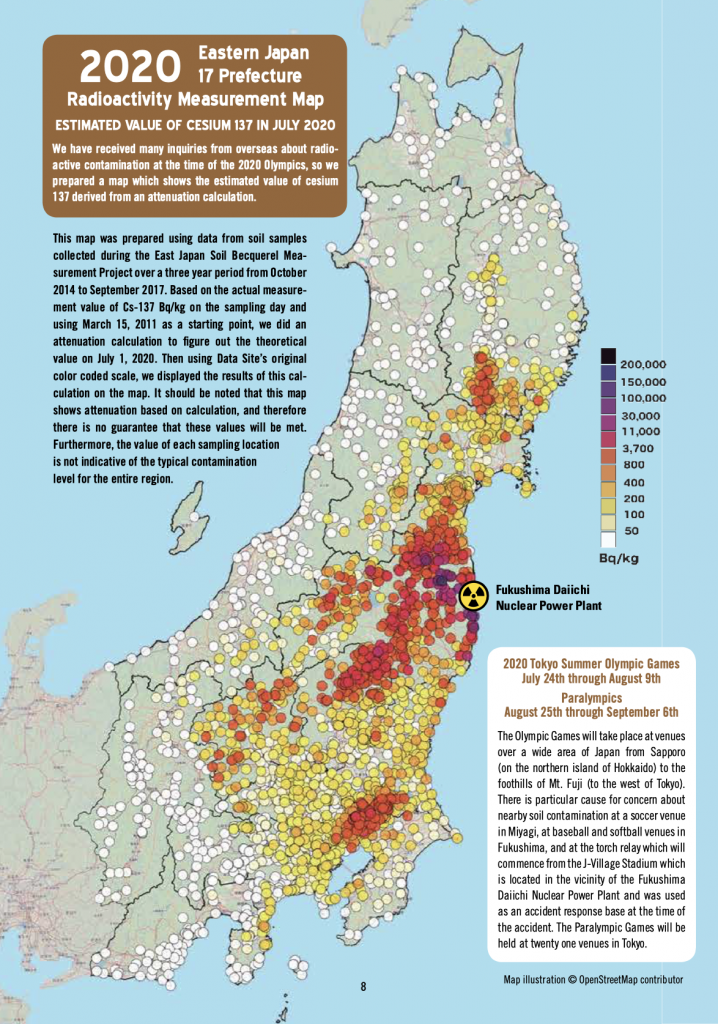
As a result of this investigation, [Minna-no Data Site] determined that the radioactive contamination was by no means limited to Fukushima Prefecture and that one hundred years from now there will still be several highly-contaminated areas where humans should not live.
Uninhabitable: Booklet by Citizen Scientists Uncovers True Extent of Radioactive Contamination in Japan’s Soil and Food
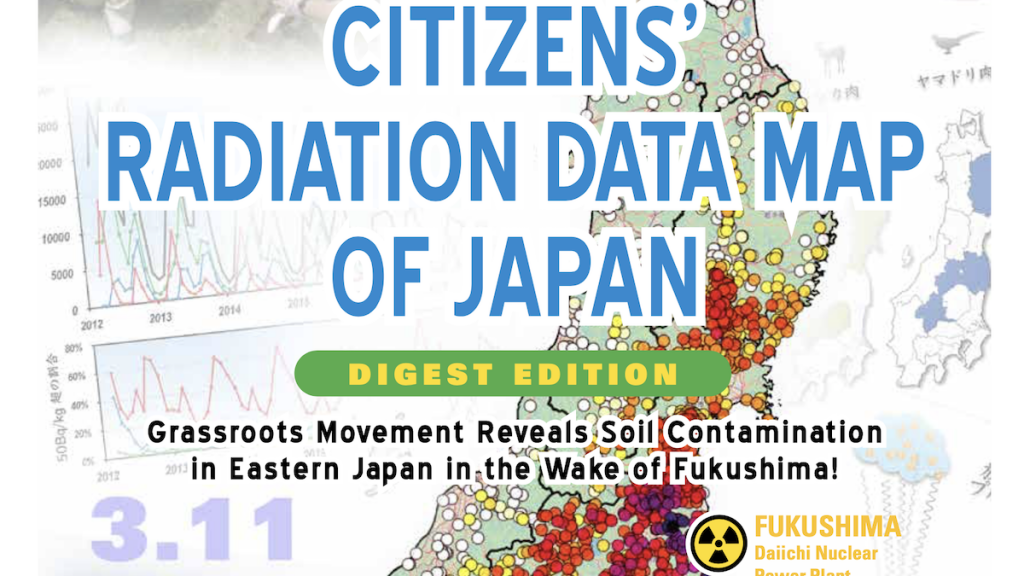
“As a result of this investigation, we determined that the radioactive contamination was by no means limited to Fukushima Prefecture and that one hundred years from now there will still be several highly-contaminated areas where humans should not live.
Now, eight years after the accident, not only has the government yet to establish a criterion for radioactive concentration in the soil, but the authorities are continuing to enforce the policy of compelling people to return to their homes if the air dose rate goes below 20 mSv/year.”
By: beyondnuclearinternational
From Minna-no Data Site, a citizen’s collaborative radioactivity monitoring project
Minna-no Data Site (Everyone’s Data Site) is a network of 30 citizens’ radioactivity measurement laboratories from all over Japan.
After the 2011 Fukushima accident, many independent citizen-operated radioactivity measurement laboratories sprang up across Japan.
In September 2013, a website called “Minna-no Data Site” was established in an effort to integrate all of the radioactivity measurement data into a common platform and disseminate accurate information in an easy-to-understand format.
The world’s first “smart” nuclear bomb. But…isn’t the truly smartest thing to have a world with no nuclear bombs?
B61-12 full-weapon system demonstration at Tonopah Test Range
Facing Widespread Opposition, Feds Withdraw Nuke Waste Plan
“Some commenters said the NRC should have launched a more thorough process for making new rules instead of simply trying to reinterpret existing rules, while others said the plan should have included a process where the public could help decide whether nuclear waste would be allowed at a particular disposal site.”
BY: TRAVIS BUBENIK | courthousenews.com Dec 17, 2020
(CN) — Federal regulators are withdrawing a nuclear waste proposal that had prompted an unusually widespread chorus of opposition, including from those who worried the plan could have led to radioactive waste being shipped to local landfills across the U.S.
The proposal centered on what’s commonly referred to as “very low-level” waste, which includes things like contaminated construction debris or soil from shuttered nuclear power plants.
Under the plan, the Nuclear Regulatory Commission would have reinterpreted rules on that kind of waste so that disposal facilities without specific licenses to handle the waste could have taken it in anyways through an exception.
The proposal sparked a wave of pushback from an unlikely alliance of state regulators, environmental groups and even a prominent company in the business of nuclear waste management.
LANL contractor hits first goal in toxic waste cleanup projects
“N3B is going after the low-hanging fruit, cleaning up less than 2,000 cubic yards of contaminated dirt,” said Jay Coghlan, executive director of Nuclear Watch New Mexico. “Let’s hear their plan for cleaning up 200,000 cubic yards of radioactive and toxic wastes at Area G that are already migrating towards our irreplaceable groundwater.”
Coghlan said N3B touting this small part of the cleanup smacks of “propaganda to promote the toothless 2016 consent order.”
BY: Scott Wyland swyland@sfnewmexican.com| Santa Fe New Mexican Dec 16, 2020
Los Alamos National Laboratory’s contractor in charge of cleaning up radioactive waste produced during the Cold War and Manhattan Project has completed its first goal under a 2016 agreement.
Newport News Nuclear BWXT, also known as N3B, finished removing almost 1,800 cubic yards of contaminated soil and debris from four sites in Upper Mortandad, Upper Cañada del Buey and Threemile canyons.
Crews packed and shipped the material to a disposal site in Clive, Utah.
“Cleanup of these sites ultimately protects human health by eliminating the likelihood that contamination will reach the water system through stormwater runoff,” Brenda Bowlby, head of N3B’s soil remediation program, said in a statement.
Removing the toxic debris also protects the area’s wildlife, she added.
The cleanup project was one of 17 that N3B aims to do under the 2016 agreement between the U.S. Department of Energy and the state Environment Department.
Critics say Turkey’s unfinished nuclear plant already redundant
Turkey’s power plant building spree has resulted in an enormous idle capacity but the construction of new plants continues at the expense of taxpayers despite the country’s bruising economic woes.
BY: Thomas H. Goebel The Conversation | almonitor.com
A view of the construction site of Turkey’s first nuclear power plant, Akkuyu, is pictured during the opening ceremony in the Mediterranean Mersin region on April 3, 2018. Photo by IBRAHIM MESE/AFP via Getty Images.Turkey’s ruling Justice and Development Party (AKP), in power for 18 years, is under increasing fire for poorly planned, prodigal investments whose long-term financial fallout is coming into sharper relief as the country grapples with severe economic woes. Standing out among the most dubious investments is a series of power plants, including a nuclear energy plant still under construction, that have created an idle capacity threatening to haunt public finances for years.
East Coast nuke plants prepare to send waste to New Mexico via Holtec project
East coast nuclear power plants are getting ready to send their waste to southeast New Mexico as they are shut down.
BY: Adrian Hedden Carlsbad Current-Argus
Holtec International recently acquired licenses to decommission multiple plants as it proceeds through a licensing process to build and operate a facility to temporary store spent nuclear fuel rods near the Eddy County-Lea County line.
The ongoing license application for the first phase of the project before the federal Nuclear Regulatory Commission (NRC), would allow Holtec to store 500 cannisters at the site –or about 8,000 metric tons – of spent fuel, but the company expects up to 20 more phases as capacity is needed.
The fuel would be transported via rail from generator sites from across the U.S. to be stored in New Mexico until a permanent repository is operational.
‘Highly skeptical’: House Armed Services chairman concerned about SRS pit production
Smith’s doubts are neither new nor uncommon. And they cast a dark shadow over what many in Aiken County see as a jobs jackpot, among other things.
BY: Colin Demarest cdemarest@aikenstandard.com | postandcourier.com

Photo courtesy of High Flyer
In blunt, if not damning, remarks at a Friday event, the chairman of the House Armed Services Committee expressed serious reservations about plutonium pit production at the Savannah River Site and questioned the competency of the National Nuclear Security Administration, overall.
Likening the conversion of the failed Mixed Oxide Fuel Fabrication Facility to flipping a bowling alley into a restaurant, U.S. Rep. Adam Smith said he was “highly skeptical that they’re going to be able to turn that building into an effective pit production facility. Highly skeptical.”
John Pilger: The Most Lethal Virus is Not Covid-19. It is War.
Covid-19 has provided cover for a pandemic of propaganda, says John Pilger.
BY: John Pilger | consortiumnews.com
Britain’s Armed Services Memorial is a silent, haunting place. Set in the rural beauty of Staffordshire, in an arboretum of some 30,000 trees and sweeping lawns, its Homeric figures celebrate determination and sacrifice.
The names of more than 16,000 British servicemen and women are listed. The literature says they “died in operational theatre or were targeted by terrorists”.
On the day I was there, a stonemason was adding new names to those who have died in some 50 operations across the world during what is known as “peacetime”. Malaya, Ireland, Kenya, Hong Kong, Libya, Iraq, Palestine and many more, including secret operations, such as Indochina.
Rising Resistance to Supporting the US War Budget: The House and Senate Leaders Who Voted Against War
December 14th, 2020 – by Gar Smith / Environmentalists Against War

(December 13, 2020) — On December 8, Congress voted on H.R. 6395, the House version of National Defense Authorization Act. This year’s NDAA — approaching three-quarters of $1 trillion — consumes more than half of the nation’s entire discretionary budget. The NDAA included a 3 percent increase in military pay. That is more than double the 1.3 percent Cost of Living Increase granted to retired civilians.
Typically, a vote on funding the Pentagon passes with near-unanimity. Not so this year. According to House Roll Call 238, 78 Representatives cast a “Nay” vote for passing the Pentagon’s $740 billion budget. The bill was supported by 140 Republicans and 195 Democrats. More Republicans (40) voted against the massive spending bill than Democrats (37)
Chairman of House Armed Services Committee Reveals Great Skepticism in NNSA’s Ability to Covert SRS MOX Facility to Plutonium Pit Production, Refers to $6 Billion Project as Potential “Rat Hole”
Savannah River Site Watch https://srswatch.org/
https://srswatch.org/
Columbia, South Carolina USA For Immediate Release December 14, 2020
The powerful chairman of the House Armed Services Committee, Representation Adam Smith, has raised great doubt about the U.S. Department of Energy’s ability to pull off the project at the Savannah River Site (SRS) in South Carolina to produce plutonium “pits,” or cores, for nuclear warheads.
In an online presentation on December 11 with the Center for Strategic and International Studies, Rep. Smith (D-WA) expressed deep concern in the ability of the DOE’s National Nuclear Security Administration (NNSA) to pull off the project to convert the partially finished plutonium fuel (MOX) plant, halted in 2017, into the proposed Plutonium Bomb Plant (PBP) at SRS. The event featured Rep. Smith talking about nuclear weapons matters coming before Congress in 2021. The transcript of the event was released late in the afternoon of December 11.
Continue reading
Kairos Power test reactor comes to repurposed Oak Ridge site
Kairos Power plans to site a test reactor it has dubbed Hermes at the East Tennessee Technology Park (ETTP) in Oak Ridge, Tenn.
BY: ANS Nuclear News Staff | ans.org
The company has executed a Memorandum of Understanding with Heritage Center, LLC, to acquire the former K-33 gaseous diffusion plant site at ETTP, subject to ongoing due diligence evaluations. The announcement was made today, during the 2020 East Tennessee Economic Council Annual Meeting and Awards Celebration.
“We are thrilled at the prospect of coming to East Tennessee,” said Michael Laufer, cofounder and chief executive officer of Kairos Power. “The infrastructure available at ETTP, combined with its proximity to key collaborators at the Oak Ridge National Laboratory, makes this a great location to demonstrate our technology. The successful commissioning of Hermes builds on our current technology development programs and extensive engagement with the U.S. Nuclear Regulatory Commission. Ultimately, Hermes will prove that Kairos Power can deliver real systems at our cost targets to make advanced nuclear a competitive source of clean energy in the United States.”
Lou Martinez, vice president of strategy and innovation, added, “Today is an important day for Kairos Power. We are celebrating our 4th anniversary by showcasing an important milestone.”
UT, Texas A&M Systems hope to manage Y-12 National Security Complex and the Pantex Plant
Texas A&M is part of Triad National Security, LLC (Texas A&M, U. of California and Battelle), and is currently already managing the Los Alamos Lab.
By: Monica Kast | Knoxville News Sentinel
The University of Tennessee System and the Texas A&M University System have announced plans to compete as a team for a bid that would allow them to manage and operate both the Y-12 National Security Complex and Pantex Plant.
If the bid is accepted, the schools would join a team that would manage and operate both Department of Energy facilities, which manufacture, store and monitor the nation’s nuclear weapons.
Both universities currently partner with the plants in their state and provide “extensive workforces for the plants,” UT said in a news release.
Russian Ambassador to U.S. Sees Hope for Nuclear Arms Treaty Extension
Antonov termed the 11-year-old START treaty “the gold standard of arms control agreements.”
BY: John Grady | news.usni.org
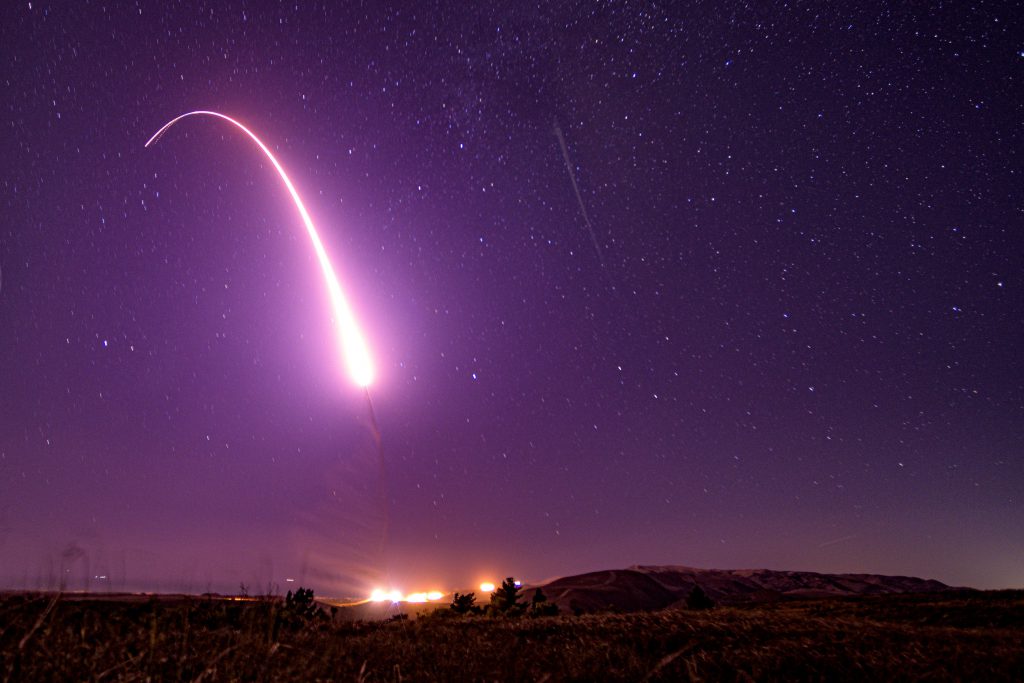
The Russian ambassador to the United States said there is still time to extend the Strategic Arms Control Treaty, due to expire in early February, even despite the upcoming presidential transition.
Anatoly Antonov, whose diplomatic career largely has been spent focused on major arms control issues, said the START treaty is a “key issue” for Russia. “We have time; we can get it done very quickly.” Speaking at a Brookings Institution online forum last week, he added, “we are in close contact with Marshall Billingslea,” the Trump administration’s top envoy on arms control.
Defying Trump, House Approves Defense Bill with Veto-Proof Majority
Cheney touted the bill’s support for nuclear triad modernization and its inclusion of a new a new fund to deter China in the Pacific, adding that it “builds on the Trump administration’s successful efforts to counter the Chinese Communist Party.”
BY: Joe Gould | defensenews.com

WASHINGTON ― The House adopted a compromise $740.5 billion defense policy bill by a veto-proof majority Tuesday, rebuking President Donald Trump, who threatened to send back the bill because it doesn’t repeal a prized liability shield for social media firms.
Republican and Democratic supporters hoped for a strong vote in hopes it would back Trump down, and they got it. The vote was 355-78 for the 2021 National Defense Authorization Act, a blueprint for next year’s spending on military and other national security programs.
While Democrats voted overwhelmingly for the bill, 40 Republicans disregarded Trump’s objections and joined Democratic lawmakers in passing the legislation. Another 37 Democrats voted against it.
Sandia National Labs to Test Nuclear Waste Storage Containers
“[Data] is needed to confirm and guide how the industry should manage storage canisters for longer than anticipated.
‘Salt can be present in the ambient air and environment anywhere, not just near the ocean. We need to be able to plan for extended long-term storage of spent nuclear fuel at nuclear power plants for the foreseeable future – it’s a national reality,’”
BY: KRQE Staff | krqe.com

ALBUQUERQUE, N.M. (KRQE) – Sandia National Laboratories reports that it is equipping three 22.5-ton stainless steel storage containers with heaters and instrumentation in order to simulate nuclear waste so that researchers can study their durability. According to Sandia National Labs, the three, 16.5 feet long canisters arrived in mid-November and will be used to study how much salt gathers on canisters over time.
Researchers will also study the potential for cracks that are caused by corrosion induced by salt and stress. Sandia reports that currently, there is not an operating geologic repository in the United States to permanently dispose of spent nuclear fuel.
As a result, spent fuel is being stored at commercial nuclear power plants in storage pools and dry storage canisters.
US nuclear warhead standoff ‘has significant implications for UK’
Kingston Reif, a nuclear analyst at the Arms Control Association, said that he would expect Joe Biden’s incoming administration to take “a critical look” at the W93 programme. It was controversial because of the weak development rationale and that “the weapon would be the first newly designed warhead to enter the US stockpile since the end of the cold war”.
BY: Dan Sabbagh | theguardian.com/uk
HMS Vigilant, one of the four Trident nuclear submarines. Photograph: Danny Lawson/PA
Britain’s most senior defence official admitted there would be “very significant implications” for the future of the Trident nuclear deterrent if Democrats in the US Congress refused to fund a next-generation warhead.
Sir Stephen Lovegrove, permanent secretary at the Ministry of Defence, said that the UK was monitoring the US standoff closely but could not say what impact a refusal to start work on the new W93 warhead would have – or how many billions it would cost.
British politicians and officials have, until now, had little to say about the long-running US row over the W93, crudely estimated to be twice as explosive as the ageing Trident warhead now used by the UK.
Peninsula Clean Energy board rejects PG&E nuclear credits
Peninsula Clean Energy board concerned over message more nuclear power sends to public
“I don’t like the idea of the nuclear on our label because it does kind of feel like a vote for it,” PCE Board Member Jeff Aalfs, said.
BY: Curtis Driscoll Daily Journal staff | smdailyjournal.com
Peninsula Clean Energy has accepted hydropower allocation credits but rejected similar ones for nuclear power from PG&E after the board expressed concern about associating with the controversial energy source but, in doing so, it will lose out of potential savings up to $10 million through 2023.
Allocations are offsetting credits given out by Pacific Gas and Electric because of the environmental benefits of hydro and nuclear powers emitting fewer greenhouse gases. Peninsula Clean Energy, or PCE, will use the hydro allocation credits to offset greenhouse gas emissions associated with system power in 2021, with plans to continue through 2023. PG&E holds the option to continue offering the credits in 2022 and 2023.
Continue reading
Rouhani: ‘No negotiations’ needed to restore Iran nuclear deal
“President Rouhani says Iran will return to its commitments that were part of the deal if other signatories do the same.”
BY: Maziar Motamedi | aljazeera.com

Tehran, Iran – Iran’s nuclear deal can be restored without negotiations despite recent escalations following the assassination of a top nuclear scientist, Iran’s President Hassan Rouhani has told world powers.
Rouhani said United States President Donald Trump “scribbled on a piece of paper” in May 2018, unilaterally withdrawing from the nuclear deal.
“The next person can put up a nice piece of paper and sign it and it just needs a signature, we’ll be back where we were. It takes no time and needs no negotiations,” Rouhani said in a televised cabinet speech on Wednesday.
New Aerial Photos Released of the Trio of Failed Nuclear Projects in South Carolina & Georgia: Plutonium Fuel/MOX (Proposed to be Converted into a Plutonium Bomb Plant) and the Vogtle & V.C. Summer Nuclear Reactor Construction Sites
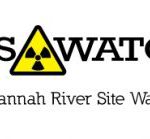 Savannah River Site Watch
Savannah River Site Watch
Columbia, South Carolina
https://srswatch.org/
November 30, 2020
Columbia, SC (aka new Nuclear Ground Zero) — Dramatic aerial photos of the massive nuclear construction projects in South Carolina and Georgia have been released by the public interest organization Savannah River Site Watch. The photos of the three failed projects, two of which have been formally terminated, were taken by a local anonymous pilot who goes by the nom de avion High Flyer.










Continue reading
Lawmakers Decide Against Nuclear Weapons Test Funding in Annual Defense Bill
Nuclear Watch New Mexico echoes the words from The Union of Concerned Scientists (UCS) in “applauding lawmakers for deciding not to authorize funds to prepare for the first U.S. nuclear weapons test in nearly three decades, an outcome UCS experts worked diligently to ensure because any move to resume explosive, underground nuclear weapons testing would undermine U.S. security.”
BY: Union of Concerned Scientists | ucsusa.org
Today, Congress released the conference report on the National Defense Authorization Act (NDAA). The Senate version had contained $10 million to lay the groundwork for a nuclear weapons test if the White House chose to move forward with one. The House took the opposite course, voting to prohibit funding for a nuclear test explosion in fiscal year 2021. The conference report includes neither provision.
“By refusing to give the test a green light, lawmakers are wisely avoiding the risk of an explosive nuclear test setting off a new round in the nuclear arms race,” said Dr. Laura Grego, senior scientist in the UCS Global Security Program.
A dozen premier American scientists with expertise on nuclear weapons issues sent a letter to Congress strongly opposing the resumption of explosive testing of U.S. nuclear weapons, saying it was unnecessary for technical or military reasons and that doing so would have negative security consequences for the United States.
How I Came to Support the Treaty Prohibiting Nuclear Weapons
“During my time serving in the Reagan administration, I came to realize that the only nuclear strategy we had was massive retaliation, which would have made the attacks on Hiroshima and Nagasaki seem almost trivial.”
BY: Lawrence Korb | justsecurity.org

About three years ago, in November 2017, I was honored to be one of about a 100 people invited by the Vatican to an international symposium, “Prospects for a World Free of Nuclear Weapons and for Integral Disarmament.” It was the first global gathering conducted after 120 nations at the United Nations approved the Treaty on the Prohibition of Nuclear Weapons (TPNW).
This treaty, which is the first legally binding international agreement to comprehensively prohibit nuclear weapons, was adopted by the U.N. on July 7, 2017, and needed 50 countries to ratify it in order for it to come into force. The purpose for the treaty was to get world leaders and citizens to consider nuclear weapons as immoral and illegal as chemical and biological weapons, whose use the U.N had previously prohibited.
Pope Francis himself was very invested in the issue. He gave the keynote address in which he condemned not only the threat of their use, but also the possession of nuclear weapons and warned that nuclear deterrence policies offered a false sense of security. He also personally thanked each of the attendees individually.
Nuclear fiasco: SCANA ex-CEO to plead guilty to fraud, get prison, pay $5 million
Former SCANA CEO Kevin Marsh has agreed to plead guilty to federal conspiracy fraud charges, go to prison for at least 18 months and forfeit $5 million in connection with SCANA’s $10 billion nuclear fiasco, according to papers filed in the U.S. District Court in South Carolina.
Nuclear News Archives – 2021
Nothing Found
It seems we can’t find what you’re looking for. Perhaps searching can help.

